
2022 GAMECHANGERS | THE PALOMA | FOOD AND DRINK FORECAST NO.790 DECEMBER 2022
DECEMEBER 2022
Regulars
6 // IN FOCUS
Movida’s Frank Camorra on venturing into the world of ceramics with Robert Gordon.

8 // NEWS
The latest openings, books, products and more.
10 // PRODUCE
Cockerel is on the rise thanks to local producers and chefs.
12 // BEST PRACTICE
Lessons in hospitality from a trip to Europe.
14 // BAR CART
Thirst quenchers, slow sippers and all things beverage related.
16 // DRINKS
Why the Paloma is the cocktail to watch this summer.

20 // PROFILE
A look at the Peruvian restaurant scene in Australia. 52 // EQUIPMENT
Prep bowls are essential for easy mise en place.
54 // 5 MINUTES WITH … S.Pellegrino Young Chef Pacific regional winner Robin Wagner.
Features
30 // 2023 TRENDS
What’s going to be big in food and beverage next year.
38 // 50 GAMECHANGERS
Hospitality celebrates 50 venues raising the bar in the industry.

2 | Hospitality
Contents
CONTENTS // December
30
16 20



SPRITZ FILM YOURSELF MAKING THE PERFECT APEROL SPRITZ USING THE 3:2:1 RECIPE SHARE ON INSTA & TAG @APEROLSPRITZAU AND #SPRITZMETOVENICE WIN! 1 OF 6 AMAZING VIP TRIPS TO VENICE AND MILAN, ITALY
A note from the editor
HOSPITALITY’S 50 GAMECHANGERS
initiative has returned for the second year, and this time, we’re shining a light on venues across the country that are leading the pack. A restaurant is only as good as its people, and there’s no doubt each individual who turns up to work plays a critical role in the success of a business from the exec chef and front-of-house team to admin, bar staff and everyone in between.
The unranked list is a compilation of restaurants that are institutions, new openers, fine diners, minimal-wasters, quick eats and boundary-pushing spaces. Congratulations to our class of 2022 — I hope you’re all encouraged to get out there and snag a seat at one of these incredible eateries.


The December issue marks the end of a big year for Hospitality, and we’ve put together plenty of content to get you through to February. Tequila has become a staple spirit for local drinkers, oft in the form of a margarita, but we’re tipping the Paloma as the drink to rival its iconic sibling. We also profile three Peruvian restaurants showcasing the diverse nature of the cuisine on a local level and have put together the top 10 trends you’ll be seeing in food and beverage as we tick over to 2023. From all of us at Hospitality, we thank you for your support and wish you a booked and busy festive season — and a relaxing break, too.

Until next time, Annabelle
Cloros Editor

4 | Hospitality
JOURNALIST Aristine Dobson adobson@intermedia.com.au ADVERTISING NATIONAL Simon York T: 02 8586 6163 F: 02 9660 4419 syork@intermedia.com.au GROUP ART DIRECTOR –LIQUOR AND HOSPITALITY Kea Thorburn kthorburn@intermedia.com.au PRODUCTION MANAGER Jacqui Cooper jacqui@intermedia.com.au CIRCULATIONS To subscribe please call 1800 651 422. hospitalitymag azine.com.au facebook.com/ HospitalityMagazine
RATES
RATES
41 Bridge Road Glebe
Australia Tel: 02
2113 Fax: 02 9660 4419 Average Net Distribution Period ending September 2019 – 11,506 EDITOR ’ S NOTE // Hello Social Follow us @hospitalitymagazine #hospitalitymagazine JATZ ARE BACK An iconic snack with a panoramic view at Kiln. @hospitalitymagazine LONG LUNCH Starting off a stellar meal with roe and chicken fat butter brioche at Bert’s. @annabellecloros TABLE FOR TWO Oysters al ají amarillo at Warike. @aristinedob Keep up with the Hospitality team
DISCLAIMER This publication is published by Food and Beverage Media, a division of The Intermedia Group Pty Ltd (the “Publisher”). Materials in this publication have been created by a variety of different entities and, to the extent permitted by law, the Publisher accepts no liability for materials created by others. All materials should be considered protected by Australian and international intellectual property laws. Unless you are authorised by law or the copyright owner to do so, you may not copy any of the materials. The mention of a product or service, person or company in this publication does not indicate the Publisher’s endorsement. The views expressed in this publication do not necessarily represent the opinion of the Publisher, its agents, company officers or employees. Any use of the information contained in this publication is at the sole risk of the person using that information. The user should make independent enquiries as to the accuracy of the information before relying on that information. All express or implied terms, conditions, warranties, statements, assurances and representations in relation to the Publisher, its publications and its services are expressly excluded save for those conditions and warranties which must be implied under the laws of any State of Australia or the provisions of Division 2 of Part V of the Trade Practices Act 1974 and any statutory modification or re-enactment thereof. To the extent permitted by law, the Publisher will not be liable for any damages including special, exemplary, punitive or consequential damages (including but not limited to economic loss or loss of profit or revenue or loss of opportunity) or indirect loss or damage of any kind arising in contract, tort or otherwise, even if advised of the possibility of such loss of profits or damages. While we use our best endeavours to ensure accuracy of the materials we create, to the extent permitted by law, the Publisher excludes all liability for loss resulting from any inaccuracies or false or misleading statements that may appear in this publication. Copyright © 2022– The Intermedia Group Pty Ltd PUBLISHER Paul Wootton pwootton@intermedia.com.au EDITOR Annabelle Cloros T: 02 8586 6226 acloros@intermedia.com.au
twitter.com/Hospitalityed instagram.com/hospitalitymag SUBSCRIPTION
Australia: 1 year (10 issues) = $99.00 (inc GST) 2 years (20 issues) = $158.40 (inc GST) – Save 20% 3 years (30 issues) = $207.90 (inc GST) – Save 30% SUBSCRIPTION
New Zealand: 1 year (10 issues) = $109.00 Asia/Pacific 1 year (10 issues) = $119.00 Rest of World: 1 year (10 issues) = $129.00
NSW 2037
9660






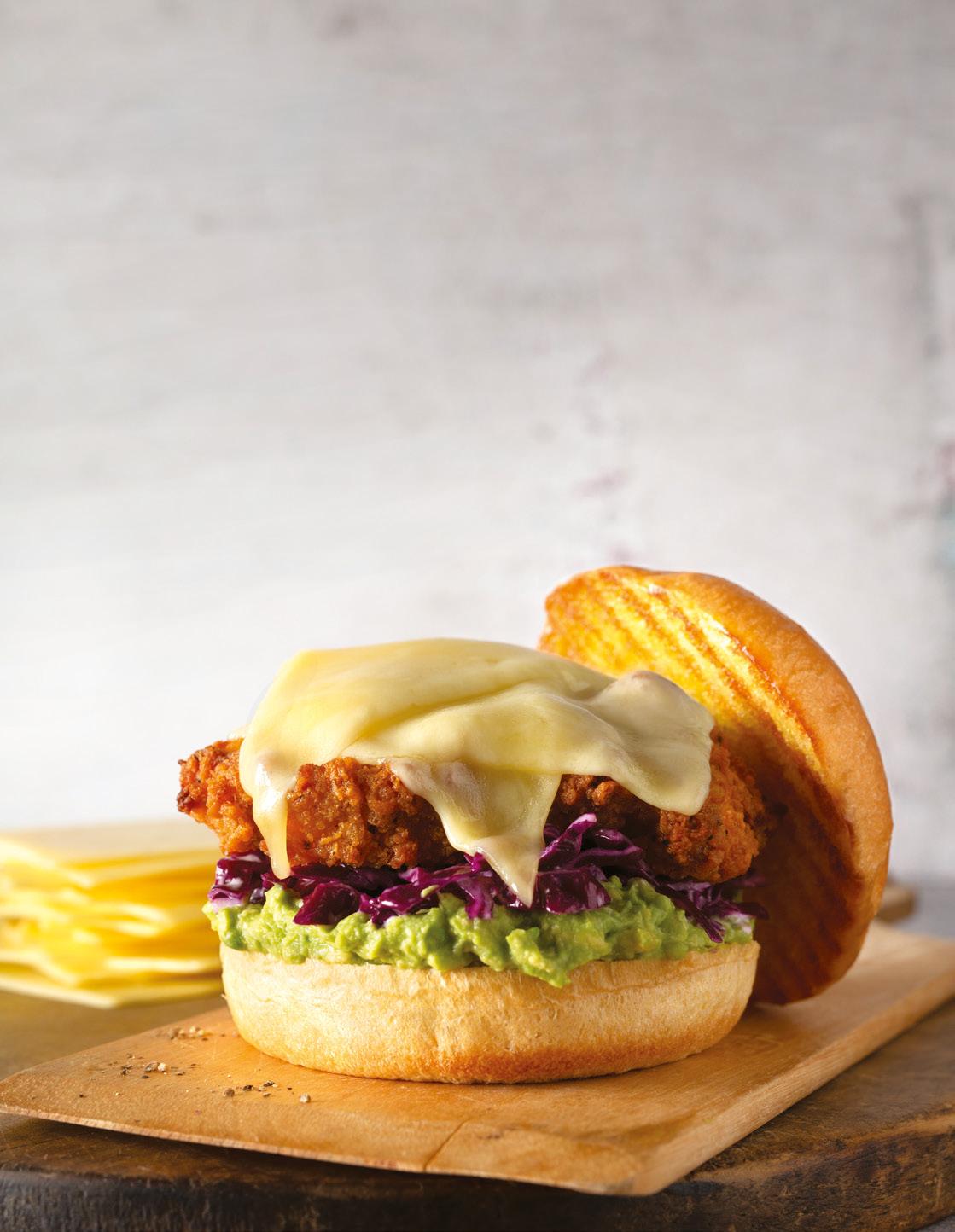
ORDER STACK-LOADS TODAY. AUSSIE AUSSIE AUSSIE HERE TO SEE OUR FAVOURITE SUMMER SESSION BRANDS. SCAN HOR ECA CON NECT Contact your local distributor to enquire or email aus.foodservice@saputo.com for further information. cheer! cheer! cheer!
Table talk
Movida is branching outside the kitchen and into yours with a new ceramics collection.
 WORDS Annabelle Cloros
WORDS Annabelle Cloros
FRANK CAMORRA’S LANEWAY tapas bar Movida is a luminary in the culinary landscape, serving up raciones since 2002. The pocket-sized venue has since been joined by Next Door, Tres a Cinco and most recently, Movida Auckland, to name a few. There’s no denying the Movida effect — it was one of the original pioneers of share plates — but Camorra has turned his eye to a new project beyond the kitchen: ceramics.
The chef and restaurateur speaks to Hospitality about his collaboration with Robert Gordon, expanding the Movida brand into the home and the olive bowl everyone needs to know about (and own).
Robert Gordon has been around since 1979. Robert ‘Andy’ Gordon picked up pottery from his mother June Dyson, who was a renowned maker, and went on to grow the family business to become one of the go-to ceramics suppliers for restaurants. Robert Gordon pieces have long held a place in the Movida kitchen and dining room, with Frank Camorra working with the business for many years to stock his venues with bespoke pieces.
The two forces decided to turn a business dynamic into something more collaborative, which would result in a ceramics collection that would be functional, durable, and of course, uniquely Movida. “We’ve used their plates for a while and have had a nice relationship,” says Camorra. “They suggested [the collection] well over a year ago and it was a no-brainer for me. I know they focus on creating quality products and we have always been really happy with what they have created for us, so I jumped at the opportunity.”
While Camorra has pursued a career in restaurants, the chef studied architecture for five years and has long had an affinity for Spanish design. Movida’s Spanish roots informed the design brief of the collection, which Camorra filled with references to traditional Southern Spanish tableware as well as historic buildings. “There’s classic Gaudi architecture and more sculptural forms, and then there are the more vibrant and geometric forms related to Moorish architecture and period Spanish history,” he says. “I spoke to the team about taking the inspiration but making sure it wasn’t cliché — forms that relate back to architecture and creating items that are utilitarian in nature. It was also about products that could go from the oven to the table.”

6 | Hospitality IN FOCUS
// Movida
x Robert Gordon
The Robert Gordon team used Camorra’s brief to determine the types of pieces that would comprise the collection, many of which were already in use in Melbourne. “The Robert Gordon guys came out to Movida and saw what we were using, and we spoke about how we could adapt them to make something different,” says Camorra. “We were using a round olive bowl with a central reservoir for pits and stackable tapas plates, which have a little side lift and are really useful because you can stack them up high and chefs can access them quickly.”
The Robert Gordon x Movida olive bowl is as functional as it is aesthetic. The sculptural double-sided piece comes in a mauve colourway and features a disc/ handle (with a cut-out at the top for ease of movement) that divides each side of the bowl for olives and pits.
Bowls of all sizes abound in the collection along with platters, carafes, pouring vessels, serving trays, jugs and mugs — all of which were put to the test by the kitchen team who gave their feedback on the pieces during the trial phase. “Some of the jugs weren’t pouring correctly — they would dribble — so it was quite the process,” says Camorra. “There was something to work through every month or two; it would have been an eight- to nine-month process in total. A lot of effort, thought and great produce goes into the food, so you want to put it on something that showcases it in the best-possible way.”
You couldn’t get a better environment for testing ceramics than a commercial kitchen, and the Movida collection has been performing well thanks to the
high-fired stoneware material it’s made from. “We’re using most of the pieces in the restaurants,” says Camorra. “The first question I asked when I came back from Auckland was, ‘How many pieces have broken?’ and none have so far. It’s such an important part of using the pieces in the restaurant — you want something sturdy and reliable. The chefs like them, too, and we’re using the large flat plates for sliced jamon and whole fish. All the bowls go through the venues as well.”
and is found in homes and restaurants, but it is made in a palette that’s in keeping with Australian design and colours. The shape and inspiration of the carafes comes from La Sagrada Família and they can be used for serving sangria or just water. There are also smaller versions of the carafes which we use for milk. I look at them and say, ‘Yep, that’s Spanish’, straight away.”
The chef also tips the pouring jug as another must-have: “You put your thumb on the side and it pours really nicely,” he says. “I’ve been using it for gazpachos and cold soups. The olive bowl is one of my favourites — just the sheer beauty of it. I think the pieces add something to the dining experience and it looks nice when there are different forms and shapes on the table.”
There’s no doubt the entire collection is visually appealing, but there are a few pieces that are well worth some extra attention.
“The handled jugs are beautiful and are a bit different to the typical metal jugs you see everywhere else,” says Camorra. “It’s a classic Southern Spanish form which is pretty iconic


Camorra is the force behind one of Melbourne’s most recognisable restaurant brands, with the collection allowing the Movida ethos to flow out beyond the dining room and into the home. “A lot of people may not have heard of us in other states, so collaborating with brands like Robert Gordon and Myer is fantastic,” says Camorra. “When we started doing cookbooks, it changed the perception of Movida — it wasn’t just that little tapas bar down a dodgy laneway — there’s authenticity and knowledge behind it, and I think it’s the same case with this. It should change people’s perceptions of Movida and improve the understanding of what we are.” ■
The Robert Gordon x Movida collection is now available at Myer.
December 2022 | 7 IN FOCUS
//
Movida x Robert Gordon
“I spoke to the team about taking the inspiration but making sure it wasn’t cliché –forms that relate back to architecture and creating items that are utilitarian in nature.” – Frank Camorra
Entrée
The latest openings, books, events and more.
EDITED BY Annabelle Cloros
Say Fuji!
Neon Lights in Tokyo
Ben Groundwater
Hardie Grant Explore; $32.99
Japan has opened its borders to travellers once again, which means Neon Lights in Tokyo couldn’t be more relevant if you’re planning a trip to the capital of the country. Award-winning travel writer and broadcaster Ben Groundwater has been a longtime fan of Japan and has packed his Tokyo-centric book with recommendations on everything from neighbourhood restaurants and bars to breweries, noodle shops and coffee spots.

Jewel in the crown
Wine-preservation experts Coravin have launched a seasonal range to celebrate the festive season. The Gemstone Collection is a limitededition range that highlights the Timeless Six+ wine by the glass line, which enables drinkers to pour a glass straight from the bottle while preserving the wine for months (or even years). The collection includes anthracite, deep emerald and dark amethyst colourways that are finished with gold accents. Each system comes with a carrying case, aerator, three replenishment capsules and six screw cap accessories. $599.95 from coravin.com.au
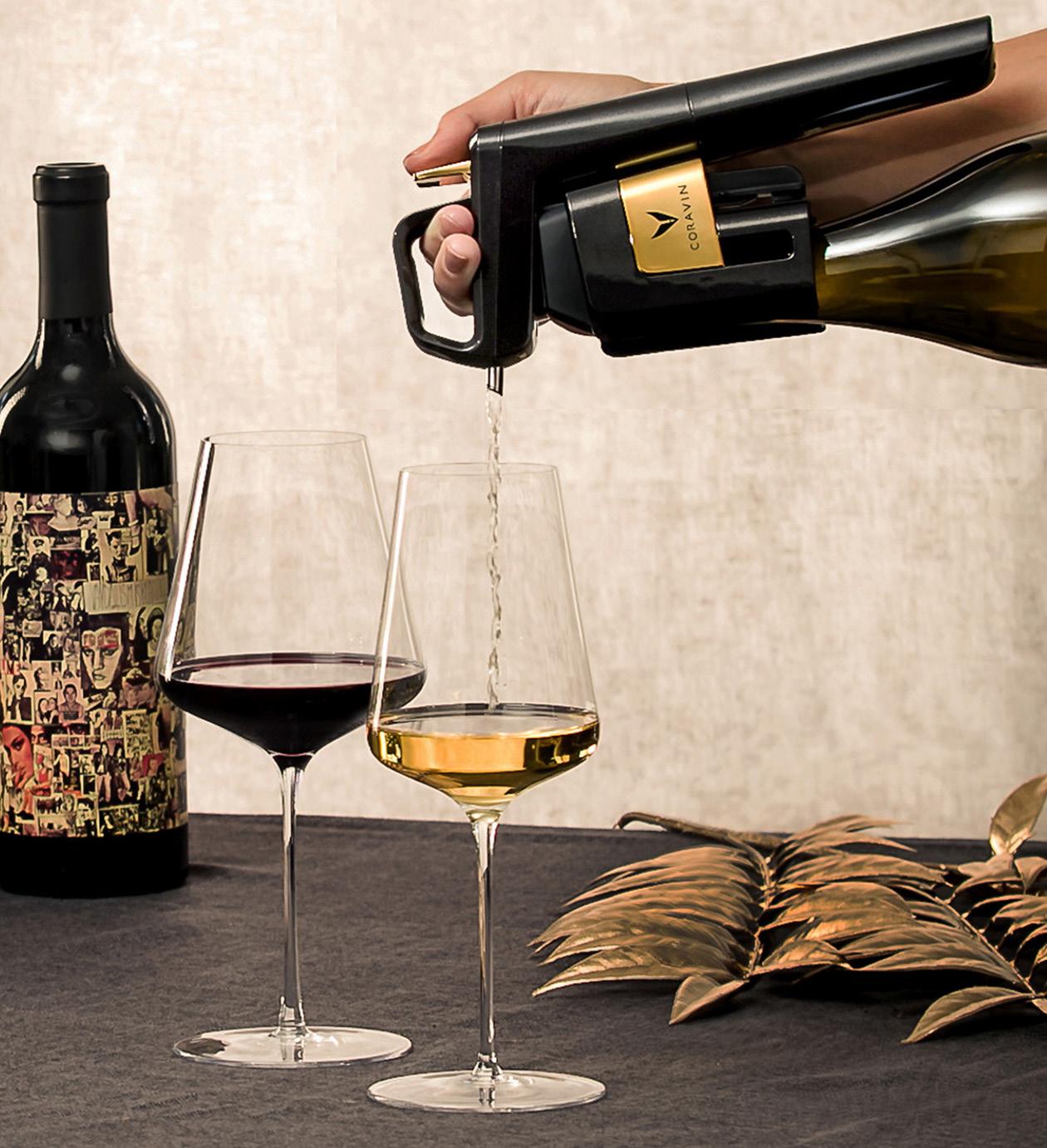
Pod life
Most venues would grow their own produce if they could, but cramped spaces often mean it just isn’t feasible — until now. Kitchen Garden by Vegepod is the answer for chefs looking to grow herbs, leafy veg and microgreens for their creations in-house. Kitchen Garden features a selfwatering reservoir and wicking system as well as full-sun spectrum LED lights that adjust in height. Budding growers simply need to plant seeds or seedlings and watch them grow. Available in gloss black or white for $349. vegepod.com.au
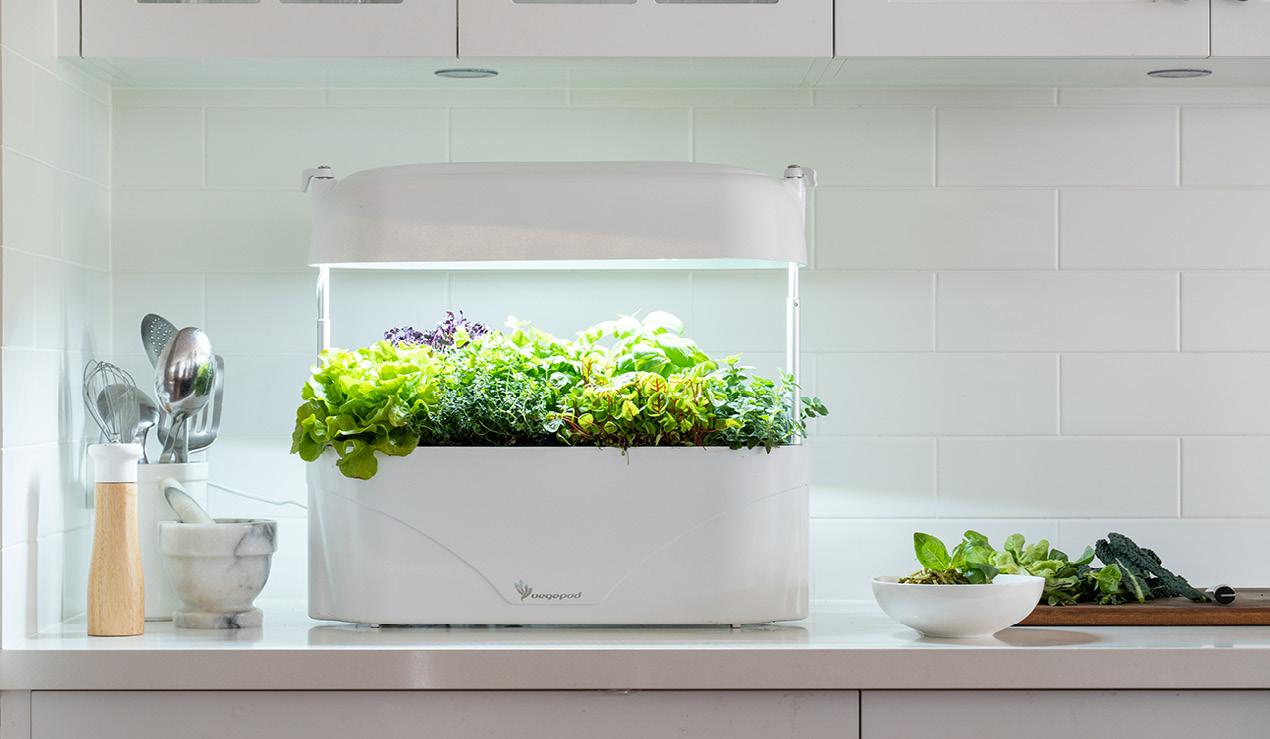
8 | Hospitality NEWS // Entrée
Time to celebrate
Icebergs Dining Room and Bar 2002-2022
Maurice Terzini ; $100 Bondi’s Icebergs Dining Room and Bar is one of Sydney’s most iconic and recognisable restaurants, retaining its staple status in the local dining scene since 2002. Restaurateur Maurice Terzini has put pen to paper to tell the story behind the food, the drinks, the art and most importantly, the people who have contributed to the Icebergs journey. The book includes personal stories as well as recipes from the restaurant’s current and past head chefs, a deep-dive into the process of putting together a memorable wine list as well as Terzini’s rules of hospitality. booktopia.com.au
Photography by Nikki To
Day to night
Sydney eatery Quick Brown Fox has launched an evening service to make the most of the warmer weather. Patrons can swing by the Pyrmont venue from Thursday to Saturday for bar snacks and cocktails from 3:30pm. Head Chef Daniel Grey has designed a selection of share plates covering anchovy toast with chilli mayo and grilled king prawns with burnt miso butter and charcuterie, to name a few. Aperol, elderflower and Rossini spritzes are on offer as well as Australian wines by the glass or bottle. quickbrownfoxeatery.com.au

Feeling festive
Tis’ the season to treat yourself, and Koko Black has plenty of options to choose from in its annual Christmas range. Classic truffles cover salted caramel and aurelia Champagne, while the festive praline box includes limited-edition flavours such as Christmas pudding and rum and raisin. Not to forget brandy eggnog marbles, pavlova bites and the candy cane hot cocoa. Available in store and online. kokoblack.com

Collective greatness
Food for Everyone has collaborated with six chefs and cooks for the Artist Collection, linking the culinary icons with six different artists. The female-led initiative highlights dishes from Analiese Gregory (chef and author); Rosheen Kaul (Etta); Annie Smithers (du Fermier); Natalie Paull (Beatrix Bakes); Alice Zaslavsky (author) and Dom Gattermayr (Florian), which have all been illustrated by artists selected by Founder Gemma Leslie. The limited posters come in A2 ($129) and A3 ($90) and are printed on paper made from recycled coffee cups. Best of all, 10 meals are donated for each poster sold. foodforeveryone.org.au


December 2022 | 9 NEWS // Entrée





Make the switch to Zero Cost EFTPOS* Join thousands saving thousands.
transactions,
terminal rental fees,
fee
$34.95
GST
month applies.
*If your business has a turnover of $10,000 per month on card
no
otherwise, a
of
+
per
Taking notes
WORDS Ken Burgin
TWO CUSTARD TARTS and two espressos for 4 euros ($6) — what’s not to love about coffee breaks in Lisbon? When you’re in food and hospitality, you can’t switch off when travelling — there is stimulation everywhere. So what did I learn on a recent sixweek trip to Prague and Naples, plus Porto and Lisbon in Portugal?
Wait staff carry themselves confidently with a tray to deliver and clear (saving so many steps) and often with a coin purse or EFTPOS machine on their hip ready to handle payments. Sometimes the machine also takes orders and prints bills. But they generally can’t add tips on the machine — they prefer cash. Memo to Aussie operators: buy rubber trays (small and medium) and train staff to use them (starting with plastic cups) — why have we stopped doing this?
QR codes are still around, but usually only for accessing menus and rarely for ordering. Wait staff in tourist venues don’t miss much, but just as people in Australia order more when using an app, there is no reason it wouldn’t work in Italy or Portugal.
Aperol is huge in Italy for takeaway or dine-in, and spritzes are cheap. The brand has done a fantastic marketing job over the past few years, and those big generous glasses were always a treat in the late afternoon (or pre-lunch). I also miss the bucket-sized gin and tonics they serve in Portugal.

Both canned fish and whole seafood are enjoyed. My favourite in Italy is always frittura, a mix of lightly fried seafood, occasionally with some fried artichoke or zucchini.
Europeans are not afraid of
bones, so eating seafood can be a bit of a meditation, not just something you gulp down. They still sell fresh octopus in iced trays in the back streets of Naples as well as fried in paper cones. Portugal makes the humble canned sardine into a major delicacy with prices to match — I’m still not sure how it’s so different to the ones I get for $3 from an Aussie supermarket.
Meat, meat, meat — what is this vegetarian thing? The attitude hasn’t changed much in these places. You’re welcome to order the veg and cheese, ‘But why?’ they wonder. There’s massive pleasure and variety for carnivores, with intense pride in local specialties.
Sfogliatella and custard tarts are specialties from Naples and Lisbon that are so delicious and usually served warm. The crunchy
ricotta-filled sfogliatella pastries are changing, with entrepreneurs presenting them with sweet and savoury fillings, but the classic corner café with staff wearing black and white uniforms sticks rigidly to the traditional biscuits, pastries and cakes they’ve presented beautifully for a hundred years. Espresso options have become slightly more flexible — a double espresso (my version of a long black) is no longer served with reluctance, and most cafés in Prague offer a flat white.
Craving Asian food? Good luck — there are a few Thai, Indian and Chinese restaurants, but the Aussie abundance is nowhere to be seen. Who hasn’t come home from an overseas trip craving laksa or a crunchy dosa? So good to be home — it’s pretty good here!
12 | Hospitality BEST PRACTICE // European hospitality
■
Observations of the hospitality sector in Prague, Lisbon and Italy.
CRUNCHY, juicy

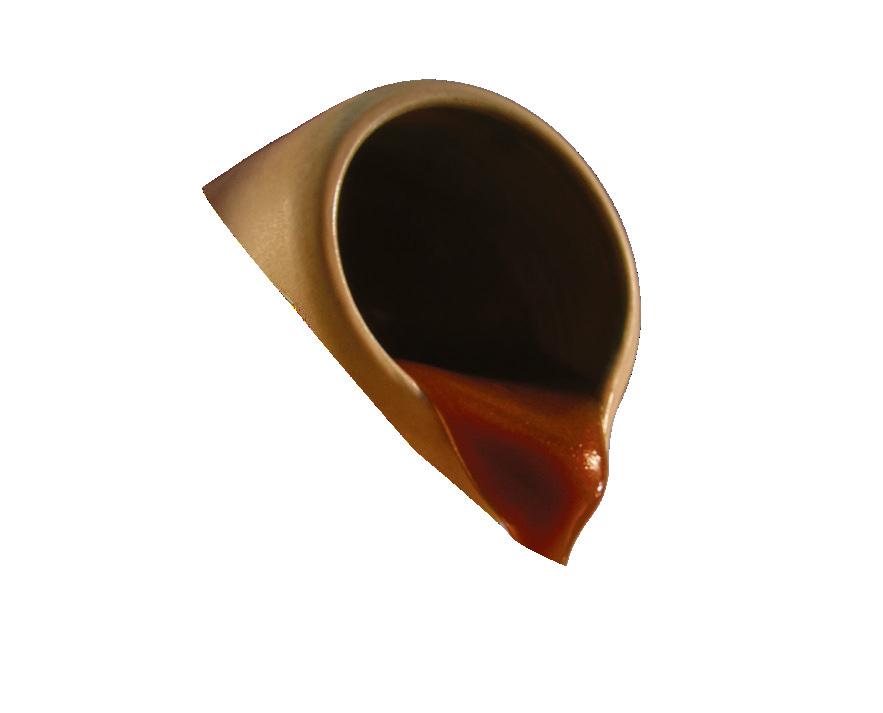

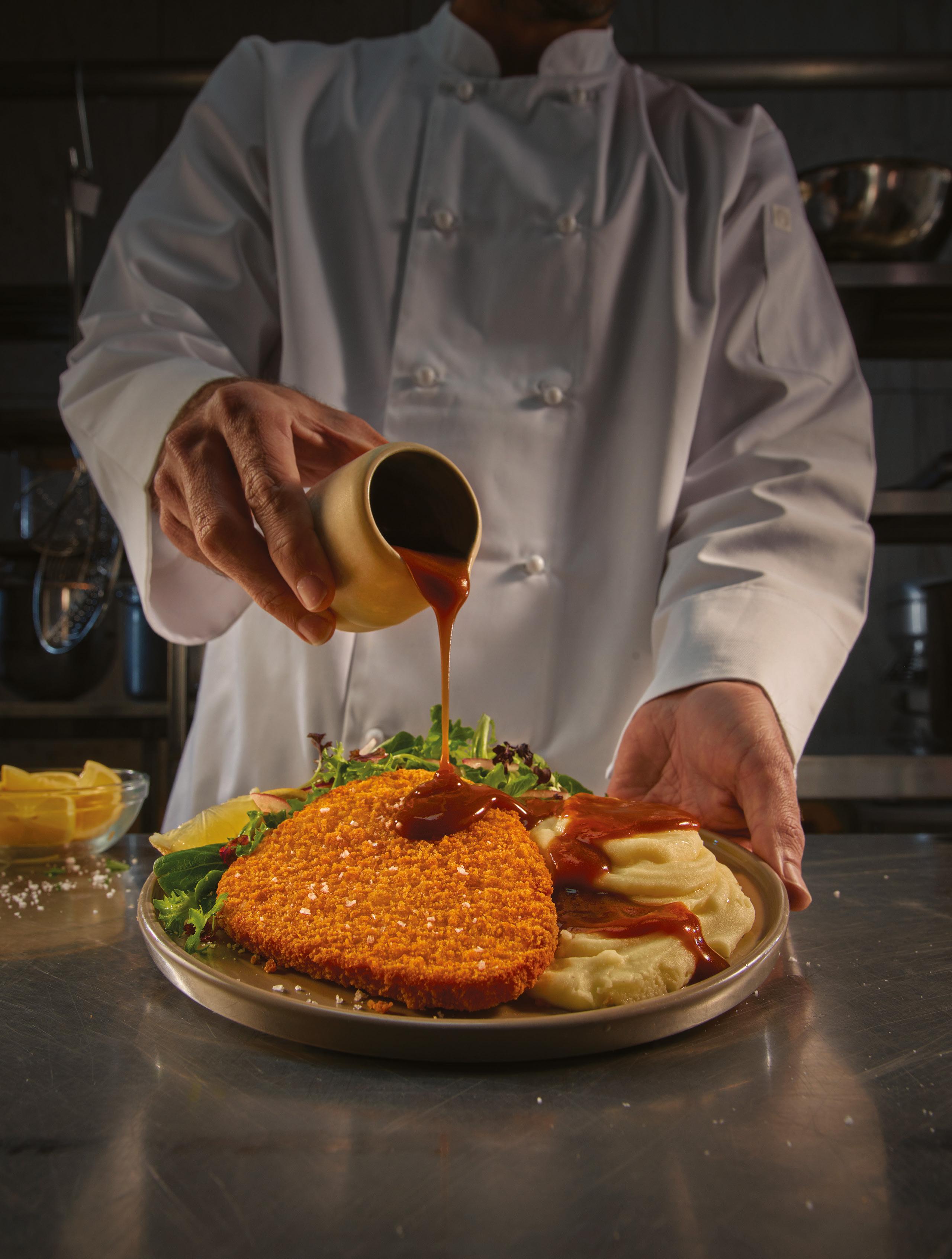
NEW
Serving suggestion
Bar cart
Thirst quenchers, slow sippers and all things beverage related.
EDITED BY Annabelle Cloros
Rare breed
Talisker has gone all out with its new release, which is the oldest to date for the distillery. 44-Year-Old: Forests of the Deep single malt scotch is a whisky inspired by one of the world’s largest sea kelp forests near the Cape of Good Hope in South Africa. There are just 1,997 bottles available of the dram, which was aged in marine oak casks and features an oily–smooth texture, umami taste and sweet chilli pepper finish. The whisky has an ABV of 43.8 per cent and retails for $5,750. Available at Dan Murphy’s and independent liquor stores. talisker.com

Feel the burn
A new trio has joined Scarborough Wine Co’s small-parcel range which spotlights wines made in experimental styles using a range of different grapes. Keepers of the Flame covers 2019, 2020 and 2021 vintage Chardonnay releases made with grapes grown on Scarborough-owned vineyards. The wines are created by makers according to different clones or oak treatment. Bottles are sold in a set or individually for $100. scarboroughwine.com.au

Don’t get it twisted
Ready-to-drink cocktails aren’t going anywhere — especially with the summer months upon us. Twisted Shaker’s bottled cocktails span a raspberry hibiscus Cosmopolitan; an espresso martini; a margarita; a cucumber gin gimlet and an Old Fashioned. The drinks are all made with premium spirits in Sydney and are designed to chill, shake and pour. Choose from 200ml single serves or make it a celebration with a 700ml bottle. twistedshaker.com
Summer mode
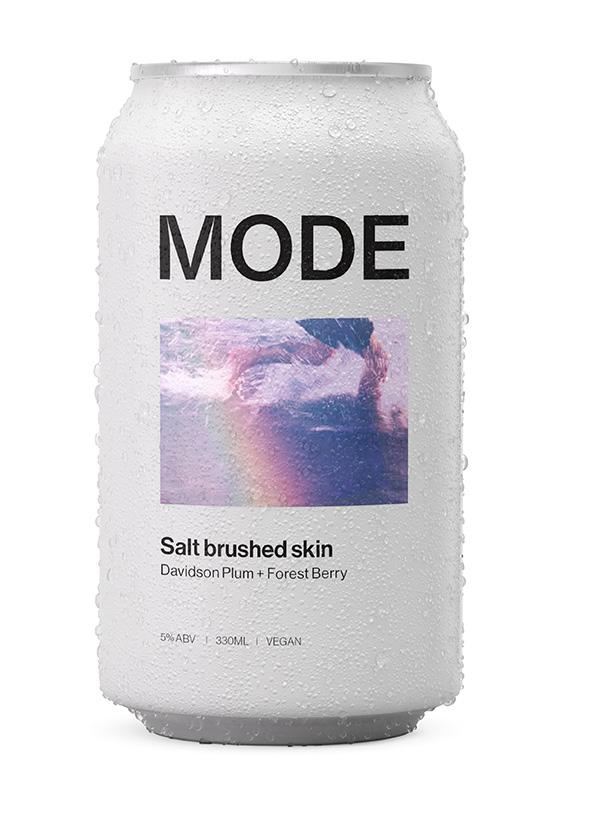
Seltzer brand Mode is joining the booming sector with drinks that hero native Australian ingredients alongside classic flavour profiles. “We have amazing native flavours in Australia, why do we need to drink something generic from overseas?” says Founder Michael Clifford. The range includes Tasmanian pepperberry, ginger and lime; Davidson plum and forest berry; yuzu, cucumber and basil and mango and pomegranate. Cases are priced at $75 and are sold at bottle shops and drinkmode.com
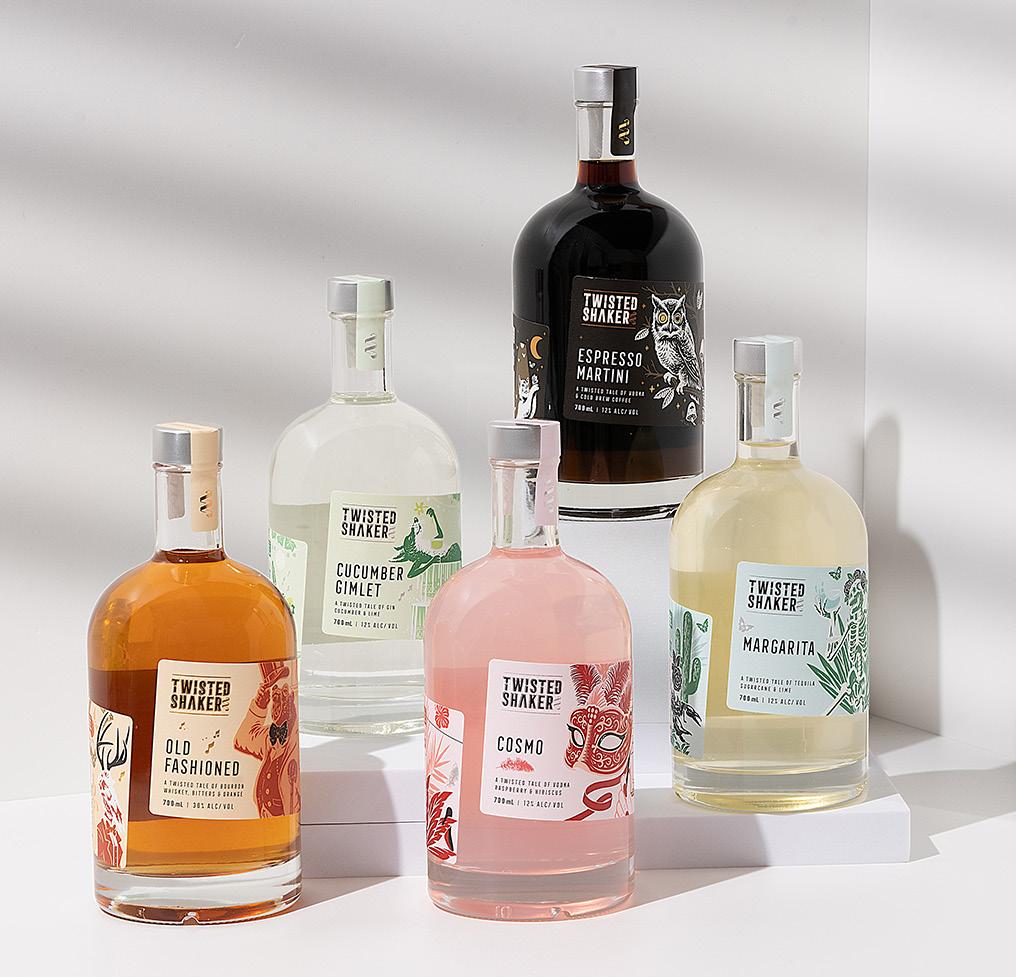
Gone rogue
Regal Rogue has launched a limitededition amaro, branching out from vermouth for the first time since its 2011 inception. Bold Aged amaro is a collaborative effort between the brand, Bartender Evan Stroeve, See Saw, Starward and Crawley’s. The liqueur sees Regal Rogue Bold Red blended with botanicals and syrups before being aged in French oak red wine barrels previously used for whisky for a period of six months. Best enjoyed in a Manhattan or over ice. Available at swiftys.com.au
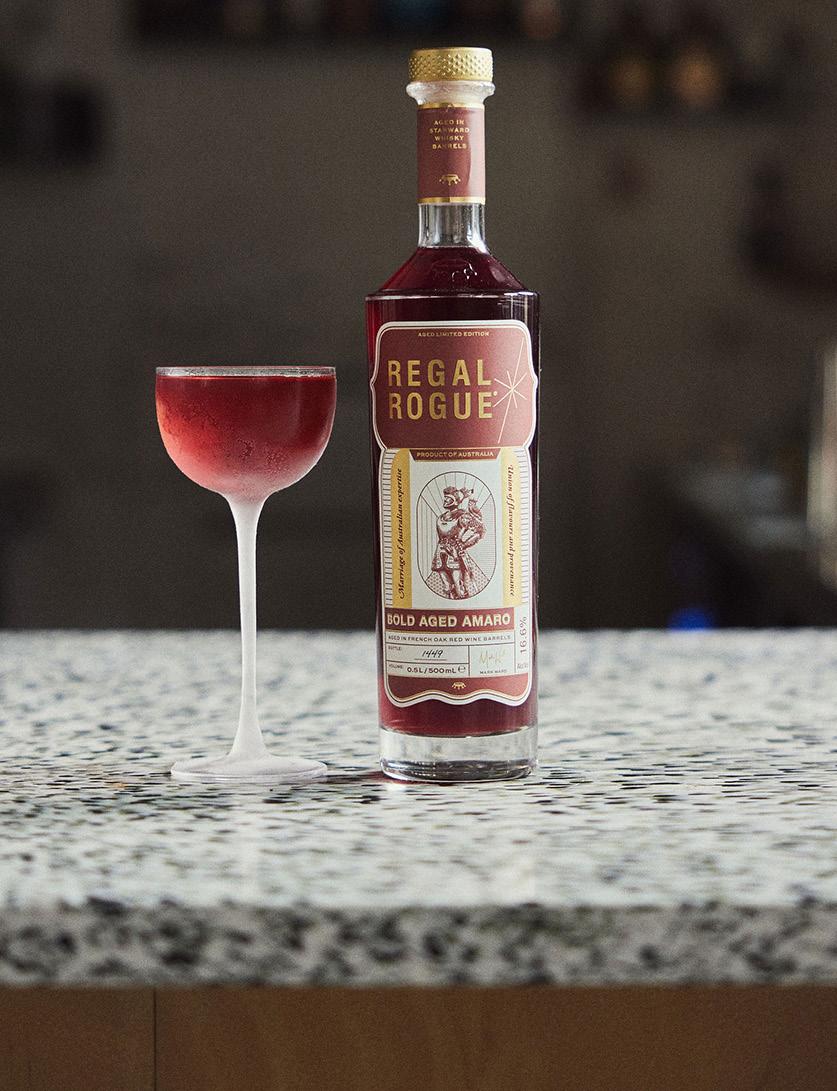
NEWS // Drinks
14 | Hospitality
ATTENZIONE BARTENDERS!

refreshing with a unique bittersweet taste, Aperol Spritz is the perfect prelude to a meal. The ingredients for an Aperol Spritz are simple, but it’s the ratio between them that is key. This is where the 3:2:1 rule comes in.
Begin with a generous amount of ice; a crucial element according to Italian ex-pat and Maybe Sammy bar owner Stefano Catino. “Make sure to use a lot of ice,” he says. “The wine glass has to be full, we don’t want to see floating ice”. The more ice, the colder the drink will stay, meaning less dilution overall. Next pour in 90ml of Prosecco, followed by 60ml of Aperol. Finally, add a dash of soda water, give it a quick stir and garnish with an orange wedge.
If you think you’ve got what it takes to make a mean Aperol Spritz, you could be in the running to win a trip to Venice, Italy –the home of Aperol! See below for more details.

WIN 1 OF 6 TRIPS TO VENICE & MILAN PERFECT SERVE
Paloma
The sibling of the margarita is ready for the limelight.
 WORDS Annabelle Cloros
WORDS Annabelle Cloros
DRINKS // Paloma
16 | Hospitality
THE DRINKING PUBLIC has well and truly adapted tequila as a staple, finally coming to appreciate the nuances of the spirit made from Mexico’s native blue agave plant. It’s been a long journey for some (myself included), whose early tequila experiences involved a red-capped bottle consumed a little too quickly. But perceptions change — and thank goodness for that.
Beyond a shot, the margarita is the most common application tequila is used in, with a version of the cocktail found at most venues; regardless of culinary direction. You could say drinkers are currently in the comfort phase when it comes to how they drink tequila, but now is the time to venture beyond the margarita and look to its fun, zingy sibling: the Paloma.
Hospitality speaks to El Primo Sanchez Bar Manager Eduardo Conde about the Paloma’s status in Mexico, blanco vs reposado tequila and why the drink is one to watch this summer.

The Paloma likely originated in Mexico in the 1950s and poetically translates to ‘dove’ in Spanish. The cocktail is oft made with blanco tequila combined with pink grapefruit soda (and/or pink grapefruit juice), lime juice and agave syrup in a highball glass rimmed with salt and finished with a slither of citrus.
It’s a no-fuss, high-impact drink, which means it’s a regular at the bar and in the home. “You mainly see the Paloma at parties and weddings in Mexico,” says El Primo Sanchez Bar Manager Eduardo Conde. “It’s been underrated in Mexico for a long time, but it’s become more popular over the past couple of years. People enjoy highballs and seltzer-style drinks, so it has more of a presence in bars.”
You’ll find it on the menu (and potentially on tap) at El Primo Sanchez in Paddington, Sydney. Public Hospitality and the Maybe Sammy team are behind the new addition to the hospitality scene, which has seen the ground floor of The Rose Hotel transformed into a Mexican-inspired bar that opens this month. “You can still expect the same high level of hospitality, playful energy, brilliant cocktails and attention to detail as our other bars,” says The Maybe Group Co-Founder Vince Lombardo. “It will just be wrapped up into a Mexican environment with more of a laidback pub vibe than a high-end cocktail bar.”
The grapefruit component of the Paloma is what makes it, well, a Paloma. The addition is usually in the form of Squirt or Jarritos Toronja (grapefruit) soda, and while bartenders have
long taken a crafted approach to each element that goes into a drink, there’s something to be said for honouring tradition. Squirt has been a quintessential mixer since its inception and the sweet, carbonated grapefruit drink has been consumed in Mexico for decades. Fresca and Jarritos Toronja are also reached for by home drinkers and bartenders to make a Paloma. The sugar content of the soda naturally dials up the sweetness of the drink, which may come as a surprise to some. “When I arrived in Australia, I realised the flavours here are quite different … the palate is a little bit more delicate,” says Conde. “Some people like drinks sweet and others like them tart. In Mexico, we drink it sweeter, but with the climate here, people like things that are fresher and dryer.”
Despite the presence of soda, the Paloma is far from being an overtly sugary–sweet drink — it’s
December 2022 | 17 DRINKS // Paloma
“People are trying to drink better, and a Paloma allows you to appreciate how good a tequila is.”
– Eduardo Conde
The drink can be assembled in a highball glass
El Primo Sanchez is located inside The Rose Hotel

based around grapefruit, after all. Bartenders can opt for pink or yellow grapefruit and make the most of seasonality by adding fresh juice to the cocktail in addition to (or in place of) soda.

“The grapefruit gives the drink tartness and it’s quite refreshing, so people can have more than one,” says Conde. “I would also like to see people experiment and make their own sodas. There’s a lot to play around with, so I would consider infusing mango leaves or lemon myrtle to make a mango soda with a citrus component.”
Tequila is the base of a Paloma, but it isn’t the easiest or cheapest spirit to get your hands on these days thanks to its global boom in popularity.

“It’s hard to bring in tequila and there’s a shortage in Mexico as well,” says Conde. “But we’re going to have a selection at El Primo Sanchez to cater to everyone; we want to make sure people appreciate it and can try different options.”
The composition of a Paloma is a timesaver for bartenders — there’s no elbow grease required. But if bartenders are planning on serving the cocktail with a salt rim, it’s a good idea to do that first. While standard salt does the job, Conde uses the salt rim as an opportunity to introduce another layer to the drink. “I like using Olsson’s red gum smoked sea salt, which works really well with the cocktail,” he says.
“Otherwise, you can do pink salt, chilli salt or just do half the rim with smoked salt and leave the other half free. The flavour of the drink changes with the salt.”
Conde builds a Paloma in a highball glass and starts by measuring out the tequila, which is not something you’d usually see happen in Mexico.
Pink grapefruit is often used to make a Paloma
The drink can be tweaked with housemade sodas
There are several different categories of tequila, with blanco, reposado and anejo the most commonly used by bartenders. Palomas usually call for blanco, which is known to be the ‘purest’ form of tequila. Blanco is colourless and is bottled directly as it does not go through an ageing process, resulting in a citrus-driven flavour profile. “It’s traditionally made with blanco tequila because it has notes of citrus,” says Conde. The bartender favours Don Julio blanco, tipping Patron Silver, Fortaleza, Tio Pesca and Don Armando as other “solid options for a Paloma”.
Reposado can also be used, but allowances need to be made when it comes to the recipe. Reposado tequila is matured in oak casks for a minimum of 60 days, with the agave flavour mellowing out and leading to a golden liquid with notes of sweet spice and fruit. “Reposado has more vanilla and there’s complexity,” says Conde. “Pink grapefruit goes with blanco, so you have to change the soda to lemon myrtle for example with reposado and use a different fruit.”
“I do 45–50ml of tequila and then 100ml of homemade soda or StrangeLove’s salted pink grapefruit soda,” he says. “Then I add 10–15ml of lime juice because I like it more on the citrusy side and add in 5ml of agave, ice, a pinch of salt and finish it with a wedge of grapefruit or another citrus garnish.” And that’s it.
The future of the Paloma looks bright, and there’s no doubt the cocktail fits right into the current diaspora of drinks made from high-quality spirits teamed with components that complement a liquor, rather than mask it. “People are trying to drink better, and a Paloma allows you to appreciate how good a tequila is,” says Conde. “You can definitely taste the spirit more in a Paloma compared to a margarita, which has more sugar. The Paloma has a less-intense flavour profile, so the tequila can come through.”
With the warm weather in full swing and margarita fatigue setting in, there’s a prime opportunity for venues to contribute to the evolution of tequila on home soil. There’s a wide world of tequila-centric cocktails to put on the menu, and the Paloma is a good place to start. ■
18 | Hospitality DRINKS // Paloma

celebrating unforgettable moments? Make it a Lyre’s non-alcoholic sparkling.
To find out more about making it a lyre’s THIS festive season, CONTACT HELLO@LYRES.CO
A taste of Peru
PERU’S NATURAL LANDSCAPE covers the mountains of the Central Andes, the Amazonian rainforest, the desert and the coastline. The national cuisine has been shaped by indigenous cultures alongside the influences of 500-plus years of migration from Europe, Asia and Africa.
The social and geographical influences have created an intricate culinary landscape that has resulted in the establishment of secondary cuisines including Chifa (Peruvian-Chinese), Nikkei (Peruvian-Japanese) and Crillo (Peruvian-Spanish).
WORDS Aristine Dobson
Peruvian-inspired restaurants are becoming more prevalent in the local hospitality scene, with chefs and restaurateurs taking a contemporary approach that ventures beyond tradition to deliver a truly unique dining experience.
Hospitality looks at the Peruvian food landscape in Australia with three restaurants, covering key dishes, traditional ingredients and how each establishment aims to represent culture through food.

20 | Hospitality PROFILE // Peruvian
Hospitality investigates the intricacies of Peruvian cuisine with three restaurants.



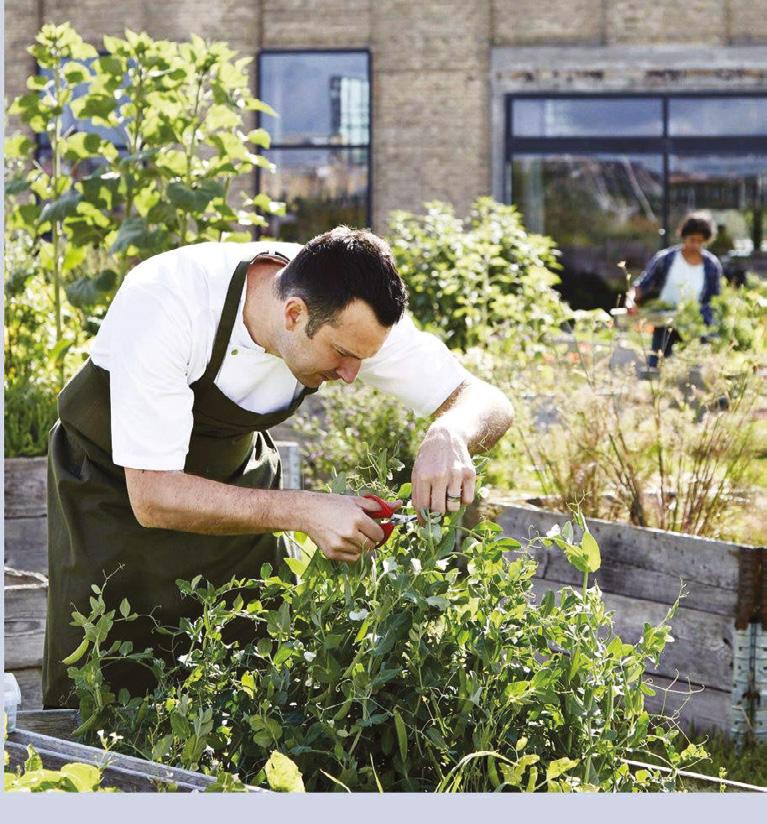

celebrates all the things I love about my country, which is the edgier, more local scene in Peru [rather] than a tourist’s perspective of it.”




22 | Hospitality
RESTAURANT PROFILE
//
Pepito’s Marrickville
“Pepito’s
José Alkon
Pepito’s Marrickville
The Sydney taberna is colouring outside the lines when it comes to Peruvian cuisine.
WORDS Aristine Dobson PHOTOGRAPHY José Alkon
TABERNAS, OR TAVERNS, are commonplace on the bustling city streets of Peru. The venues are casual eateries where people can eat and drink with a soundtrack of live music. Peruvianborn José Alkon wanted to recreate the experience in Sydney’s Marrickville and spearhead a dining experience that reflected the multicultural landscape of Peru. He opened the doors to Pepito’s (named after his father) in 2020, which showcases the regional diversity of Peru through the lens of taberna food.
Alkon speaks to Hospitality about why migration has played a significant role in Peruvian cuisine and how Pepito’s menu veers away from traditional bounds.
José Alkon first moved to Australia from Lima in the late ’80s with his family, who are originally from Huánuco, Peru. He says Peruvian cuisine has been shaped by the amalgamation of indigenous and global cultures. “There’s Spanish, African, Chinese and Japanese,” says Alkon. “They brought along their style of preparing food while taking the abundance of natural resources of Peru into account, using their skills and the new ingredients to create a sort of wild fusion.”
Alkon wanted to celebrate Peru’s history of migration through his Sydney restaurant Pepito’s, which is based on a Peruvian taberna. “They are casual, family run venues usually centuries old with a really loud, fun atmosphere where people go to hang out,” says Alkon. “I was more interested in creating an authentic environment rather than an authentic food experience.”
When venues open with a specific culinary
Pepito’s replaced a former seafood market Anticuchos are common in the Central Andes
Peruvian chillis are available in paste form Pisco-centric cocktails are on offer at Pepito’s
direction, there is often an expectation for restaurants to deliver a level of authenticity and familiarity, but Pepito’s is making new traditions. “You can’t be authentic if you don’t have the ingredients, so we say we are an interpretation,” says Alkon. “Just like [the people who] went to Peru to recreate their dishes using Peruvian ingredients, we are doing Peruvian food using Australian ingredients.”
Meat, fruit, vegetables and sustainable seafood are all locally sourced for dishes, but traditional Peruvian ingredients such as specific chillis are harder to come by in Australia. Ají amarillo, ají panca and rocoto are integral to Peruvian cookery, but can also be imported in paste form. “We’re fortunate to have some growers [producing] Peruvian chillies, but not enough to sustain a restaurant for a whole year, so we rely on chilli pastes we bring in from Peru,” says Alkon.
The menu is divided into five sections: platos frios (cold dishes), sanguches (sandwiches), snacks, plato de fondo (main courses) and anticuchos (grilled meats). Diners are encouraged to order multiple dishes and share amongst the
table. “Traditionally, Peruvian food is known for its large quantities,” says Alkon. “I wanted to do more of a tapas presentation where you can try five or six dishes in one sitting, rather than coming in and having one or two.”
A popular order is a home-cooking staple called causa de camarones, a lasagne or terrine-like dish with layers of mashed potato, prawn and avocado. In Peru, it is typically served in larger slices, but the Pepito’s version is more pared back. “We wanted to take the core ingredients and recreate it so people could enjoy it visually and for it to be restaurant quality,” says Alkon.
Another “rockstar” dish is a type of ceviche made with leche de tigre or tiger’s milk in Spanish. The name refers to the marinade made from lime, garlic, spices and chilli. “We wanted to celebrate the marinade, so it comes in a cup,” says Alkon. “It’s fish, cooked prawns and fried calamari on top, so you can imagine the balance of the lime, the crunchiness of the calamari and the chilli. We get people to drink the juice at the end because it’s the best bit.”
Pepito’s is all about an experience that veers “outside the traditional image of panpipes, salsa and reggaeton”, says Alkon. The concept has allowed the restaurateur to explore his own heritage and give diners an insight into a different side of Peruvian cooking. “Pepito’s celebrates all the things I love about my country, which is the edgier, more local scene in Peru [rather] than a tourist’s perspective of it. It gives us the freedom to try different things with the food, so we don’t have to follow traditional protocols.
December 2022 | 23
RESTAURANT PROFILE //
Pepito’s Marrickville
Warike
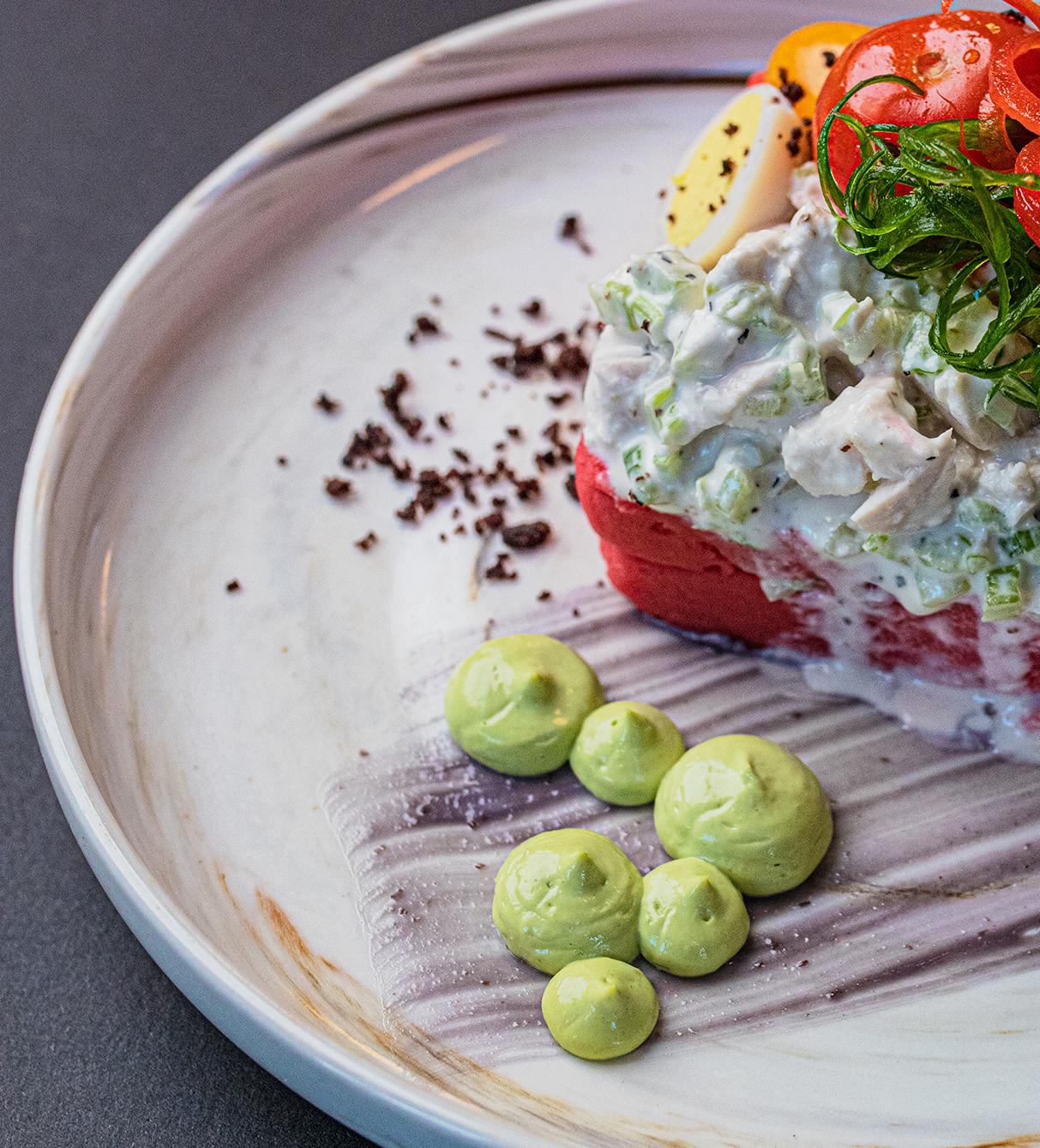

 Head Chef Hector Chunga takes diners through the regions of Peru one dish at a time.
Head Chef Hector Chunga takes diners through the regions of Peru one dish at a time.
RESTAURANT PROFILE //
24 | Hospitality
WORDS Aristine Dobson
Warike
THE WORD WARIKE (or warique) has two meanings in Quecha — an indigenous language spoken in Peru — when broken apart. ‘Wa’ translates to unknown or hidden and ‘rique’ means stew. Hector Chunga, Luis Guzman and Valeria Finogeeva thought it was a fitting name for a restaurant, which is fittingly tucked away on Devonshire Street in Sydney’s Surry Hills.
Warike launched earlier this year and has become known for its menu that lists regional dishes based on Chunga’s Peruvian roots and his career-defining experiences in the kitchen. The chef talks to Hospitality about the complexity of Peruvian food, utilising different chilli varieties and elevating traditional recipes.

Hector Chunga’s mission has always been to promote Peruvian cuisine overseas. After training and working in restaurants in Peru, the chef moved to Japan where he cooked for high-ranking officials at the Embassy of the Republic of Peru, honing his skills in both Japanese and Peruvian cooking techniques.
Chunga made the move to Australia to open Warike, a restaurant that aims to showcase regional Peruvian food. “There are seven regions in Peru,” says Chunga. “Every city and small town have different kinds of food [cooked] with different techniques and produce.”
Warike’s menu covers dishes from the Central Andes to the coast. While it is all-encompassing, a common thread is the use of Peruvian chillies, which are integral to traditional dishes. There are at least 50 varieties of chilli peppers grown in Peru, each with varying spice levels, colours and flavours.
The kitchen team uses ají amarillo, ají panca, ají limon and rocoto for different cooking applications. Using Peruvian chillies allows Chunga to create contemporary dishes with an underlying element of authenticity. “We try to use all the chillies we have to create new recipes, but we like to keep the Peruvian flavour,” he says.
While ají amarillo and ají limon provide brightness to dishes, ají panca has a smokier flavour that is ideal for
slow-cooking and charcoal grilling. Rocoto is perhaps the spiciest chilli at the restaurant and is strictly used in smaller amounts. “Rocoto looks like a capsicum, but it’s very spicy,” says Chunga. “You have to work very carefully.”
Chunga has a knack for seafood dishes, notably from his hometown of Piura in northern Peru. “We have really beautiful beaches in Piura,” says Chunga. “We have really good seafood and fish, so most of the recipes are [fish-based].”
Tiraditos (Peruvian raw fish dishes) and ceviche are a specialty at Warike and are not only reflective of the chef’s childhood, but his love for Nikkei cuisine. “We use Japanese techniques to cut the fish and make a crudo,” says Chunga. “We also use Japanese pickles to mix with the proteins.”
An example is conchas y caballa, which sees blue mackerel and Hokkaido scallops coated in a smoked rocoto sauce and topped with Japanese salmon roe, dill and chalaquia, a mixture of onion, chilli, coriander and lime. The dish is a riff on a traditional mackerel ceviche, but Chunga has turned it into a tiraditos-style menu item. “I try to mix the ingredients with more sophisticated products such as Hokkaido scallops and roe to make a tiraditos,” says Chunga. “The flavour reminds me of my childhood, but it’s presented differently, and I use different techniques.”
While the restaurant has a selection of Nikkei-inspired dishes, it also delves into Chifa, a fusion of Chinese and Peruvian cuisines. Lomo saltado is an example; a stir fry-esque dish made with vegetables and beef accompanied by deep-fried potato chips. “The dish has a lot of Chinese influence,” says Chunga. “We cook scotch fillet on charcoal with a lomo saltado sauce that includes yellow chilli pepper, cherry vinegar, soy sauce and oyster sauce.”
Warike is a restaurant that delivers a cultural representation of Peruvian cuisine. While dishes maintain the integrity of traditional flavours, Chunga uses his culinary skills to educate diners on the progressive nature of Peru’s foodscape.


December 2022 | 25 RESTAURANT PROFILE // Warike
Pastuso
WORDS Aristine Dobson
THE SAN TELMO Group opened the doors to Pastuso on Melbourne’s AC/DC Lane back in 2014, with the venue playing an instrumental role in putting Peruvian cuisine on the map. Samuel Rivas worked as a sous chef at the restaurant for several years before taking on the head chef position.


Rivas has been busy channelling his knowledge of South American flavours into the current Pastuso offering, which is all about heroing the dishes found across Peru’s diverse lands. The chef speaks to Hospitality about traditional cooking techniques and ingredients and his predictions on the progression of Peruvian cuisine in Australia.
Samuel Rivas is taking a culinary approach at Pastuso that sees the chef riff traditional cooking techniques to deliver a contemporary dining experience. “We say we are not a traditional restaurant, but we are inspired by Peruvian cuisine,” says Rivas. “We try to [use] traditional techniques and ingredients and mix them with local [elements].”
Rivas is adamant on sourcing proteins and vegetables from Australian producers, relying heavily on the restaurant’s vast local network. “We like to work with small farmers,” says the chef. “We try to source products that are sustainable and in season.”
While the chef imports ají chillies, he also works with local growers to source other varieties. “We have small farmers here in Victoria who are growing ají para pintar from the north of Peru,” says Rivas. “Using things that are super fresh adds another level to our dishes. We’re trying to get more farmers to grow different chilli varieties.”
Pastuso explores the jungles, the mountains and the coast of Peru through the dishes on its menu. The venue has a dedicated ceviche and tiraditos bar, along with options that cover grilled dishes and desserts. Although it may not define itself as a traditional restaurant, each dish features ingredients or techniques that pay homage to the foundational roots of the cuisine.
An example is cooking underground; a practice that is unable to be replicated by most venues, but the Pastuso team has developed an innovative alternative to generate a similar result. “They have a technique where you put all the ingredients under the earth and cook it,” says Rivas. “It’s super difficult to do it here, but we try to represent that by using a mix of clay and coffee in our smoker.”
Meat-based dishes are a core staple at the restaurant, which has an anticuchos section featuring an array of grilled, smoked or slowcooked proteins. Alpaca meat is a staple in the Central Andes and has a unique flavour. “Back in Peru, it’s a traditional protein that has been used for thousands of years, especially in the Andean region,” says Rivas. “Everybody thinks it’s going to be super gamey and have a strong flavour, but it’s quite mild.”
26 | Hospitality RESTAURANT PROFILE // Pastuso
“We always say we are not a traditional restaurant, we are inspired by Peruvian cuisine.”
— Samuel Rivas
Head Chef Samuel Rivas combines Australian produce with Peruvian ingredients and cooking techniques.
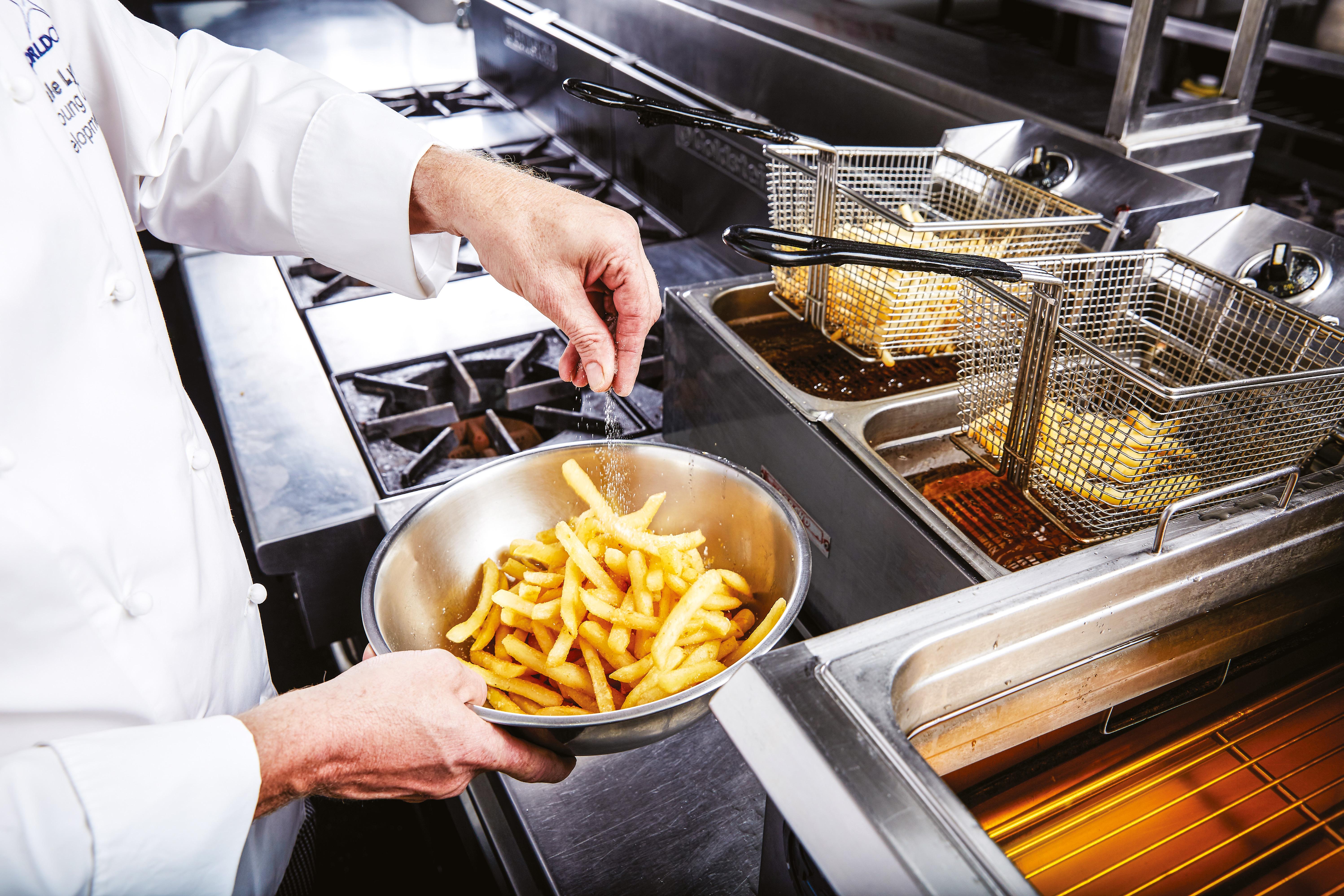





A popular dish is costillas de alpaca or grilled alpaca ribs with panca and pisco BBQ sauce and salsa criolla. It’s one of four alpaca-based items on the menu, which also includes alpaca tartare marinated in an emulsified sauce. “We cure the backstrap and mix it with a chilli emulsion that has a spicy, toffee flavour,” says Rivas.
Pastuso has long been a hub for diners to discover the many dishes that are found across Peru. Rivas is showcasing lesser-known ingredients and cooking techniques, introducing something new to the local market. “We are lucky because Melbourne is super multicultural and the industry here is massive, so people are open to trying different things,” says the chef. “The people in Melbourne are always evolving their tastes, so it makes it easy.”

The chef has seen the growth of Peruvian cuisine in Australia and believes it will continue to gain more recognition on a local and global scale. “I think Peruvian cuisine is getting stronger,” says Rivas. “I saw a Chifa restaurant in Brisbane, so I think we will see an amazing offering in the next year.” ■



28 | Hospitality
The restaurant has a dedicated ceviche and tiraditos bar
Rivas sources alpaca from local farmers in the Illawarra region
Pastuso uses sustainable seafood RESTAURANT PROFILE //
Salsa criolla is a red onion relish often paired with dishes
Pastuso
delivering Christmas since 1910

















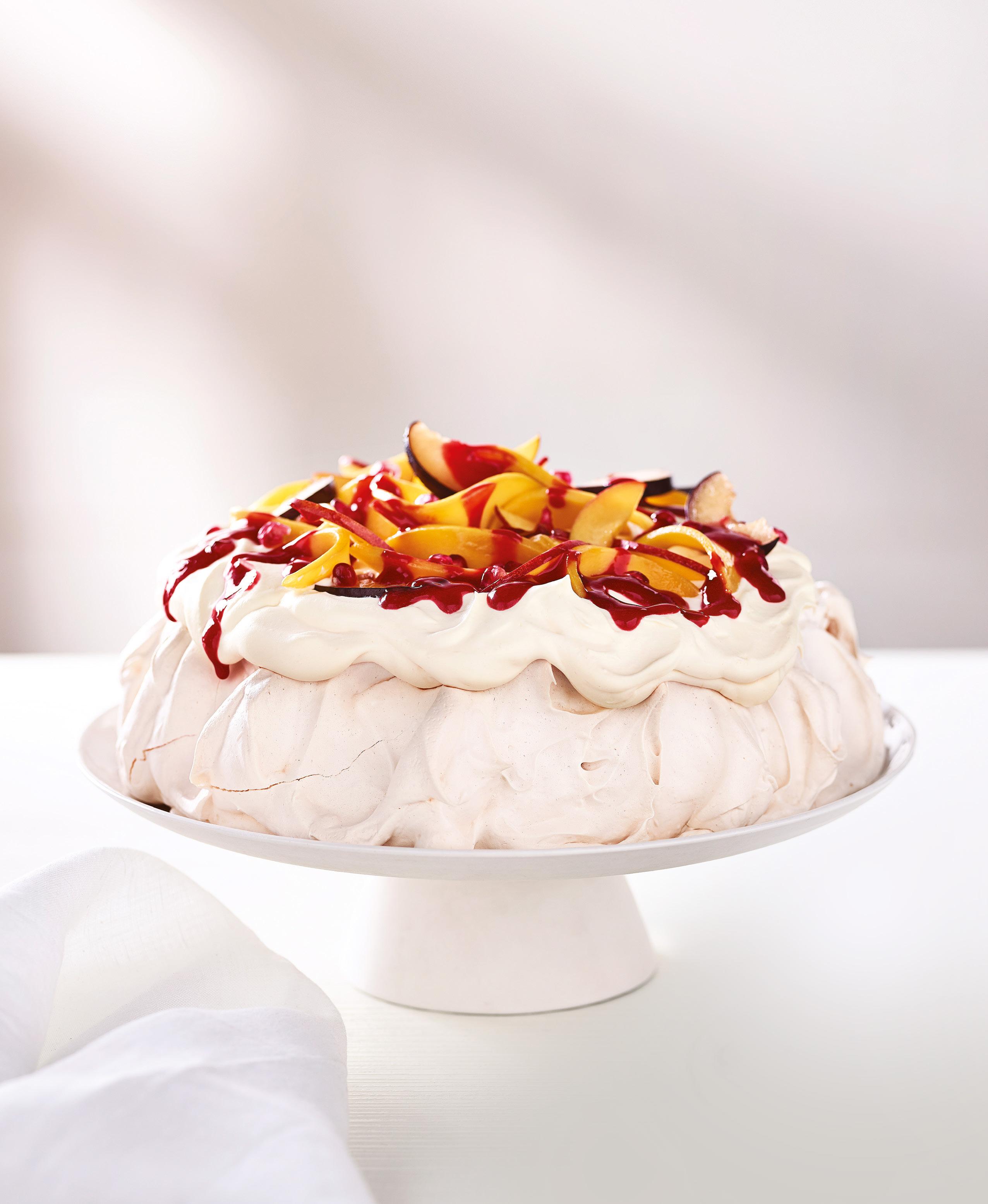
MILK FAT ALL NATURAL HALAL GLUTEN FREE For more information visit www.bullafoodservice.com.au care, craftsmanship & passion
2023 trends
Hospitality’s predictions on what will be big in food and drink.
WORDS Annabelle Cloros and Aristine Dobson
THE LOCAL FOOD and drink landscape has had a productive year, taking the time to recalibrate, get back on its feet and return to a sense of normalcy. We’ve seen venues zero in on the components that make up an eating and drinking experience patrons want to come back to — and that covers everything from the design of a space to the service and the branded ice cube a drink is served with.
Consideration is key moving into 2023, and we’re tipping a back-tobasics approach to remain front of mind alongside the establishment of working environments that empower staff to succeed in the sector. The number of hospitality hubs doing it all — bar, restaurant and shopfront rolled into one — will also continue to grow as guests look to spend more time (and money) in-venue. Here, the top 10 trends to take note of.
Kitchen gardens
The notion of paddock-to-plate is the lifeblood of a restaurant — as they say, a dish is only as good as the ingredients used to make it. Australia is fortunate to have some of the best producers in the world who dedicate their lives to providing high-quality fruit, veg, grains, meat and everything in between. But there’s something to be said for doing it yourself.
Select venues are taking on the challenge of becoming as close to selfsufficient as possible (just take a look at Brae, Margan and O.My) via their own farms and kitchen gardens. The spaces allow back- and front-of-house staff to get out of a venue and experience the cycle of planting a seed and watching it grow into an ingredient. Inspiration is oft found in nature, and there’s plenty of it when there’s an opportunity to be part of the process.
While kitchen gardens aren’t feasible for most venues, especially citydwellers — unless we’re talking Chiswick in Sydney’s Woollahra, which grew an impressive 340kg of cherry tomatoes last summer — there’s always the option to start small with planters or garden pods that are designed to grow herbs, edible flowers and chillis.
Alternatively, operators can look at collaborating directly with farmers to grow bespoke ingredients. Take the recent joint venture between Stix and Fink — the Sydney-based hospitality group has been working with the Hawkesbury farm to stock its restaurants with produce as well as redivert organic waste from its kitchens to the farm to ensure a more sustainable operation.
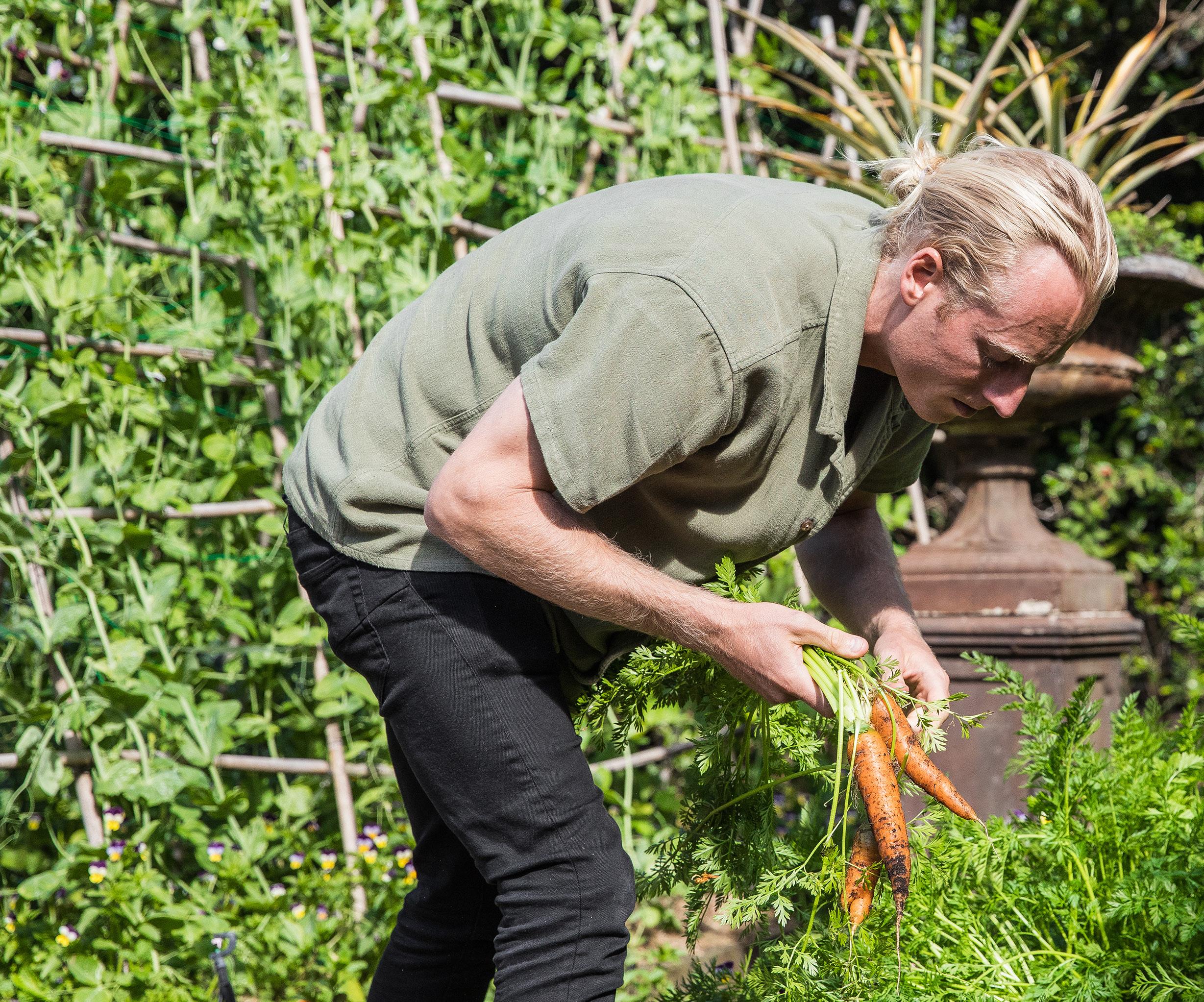
FEATURE // 2023 trends
30 | Hospitality
Bespoke serving ware

Restaurants have long been all-encompassing experiences, with interior design meshing with service, food, drink and of course, what you use to consume it. Custom eating ware covers everything from glasses and plates to serving dishes, cutlery and napkin holders. While it’s easy to stock products from a range of suppliers, sometimes a run-of-the-mill bowl just won’t work for a dish or perhaps a spoon needs to be a little larger to facilitate the eating experience. This is where ceramicists and makers come into the picture. Ceramic Studio En makes handcrafted Japanese pottery for restaurants and cafés such as Artificer. The specialty coffee-only bar and roastery in Surry Hills, Sydney, offers milkbased options as well as batch brew and filter — all of which are served in mugs and cups that are also sold at the café.
Branding goes far beyond a sign and a menu, with many venues getting the word out in alternate ways — such as on plates. Hubert’s iconic white and red plates have been synonymous with the French fine diner since it opened, with countless images posted on social media indicating exactly where a diner is eating without needing a tag. The restaurant has recently started selling the plates on their website for the first time, branching out into the retail market with dinner and dessert plate sets. The 205mm and 235mm round plates are printed in Australia and have been hand-drawn by Allie Webb, making them not only an aesthetic choice, but a very clever marketing tool.
Wood-fired cooking
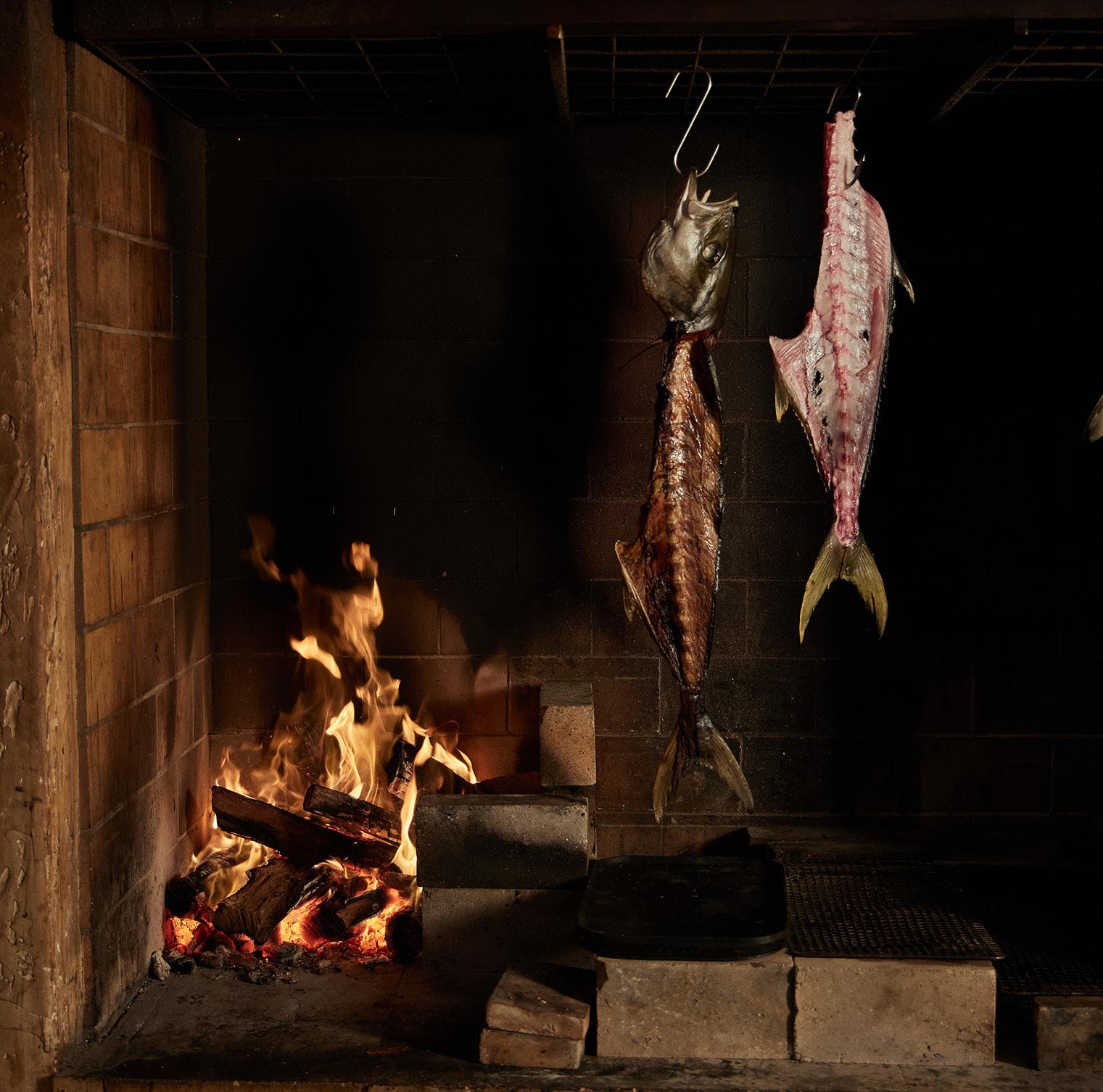
For a time, cooking with fire was mainly reserved for pizza eateries, but chefs have fast been turning up the heat when it comes to the age-old technique. Kitchen teams have discovered a newfound love for open-flame cooking in recent years along with charcoal grills and fiery hearths.
Fire-centric cookery is an ode to ancient cooking practices and is a game of skill for chefs. Arkhé is one of the latest venues to centre its ethos around cooking with fire, with Chef and Owner Jake Kellie learning from one of the best: Burnt Ends’ Dave Pynt. Kellie cooks everything from leeks to coral trout over flames, with the fine diner sourcing the best produce from across South Australia.
Cooking over fire is not limited to one type of cuisine and is prevalent across South-East Asian, Japanese, Italian and South American eateries. Brisbane modern Thai fine diner Same Same incorporates wood-fired and charcoalgrilled dishes across its menu, with Ester in Sydney’s Chippendale and Igni in Geelong two of the original fire-centric venues.
December 2022 | 31 FEATURE // 2023 trends
Staff appreciation
Finding and retaining staff has been an ever-present struggle for the hospitality industry — and the past two years has made it much more difficult with the lack of workers arriving in the country. Visa hold-ups are likely to continue, and the sheer number of vacancies means it’s a job hunter’s market, so operators need to offer staff more than just steady employment.
Some people thrive on late nights, but it’s important for venues to offer flexibility to staff when it comes to shifts. House Made Hospitality is an example of an employer that provides options; staff can work across the company’s prep kitchens during a standard workday if they have other commitments and can’t work nights at their venues.
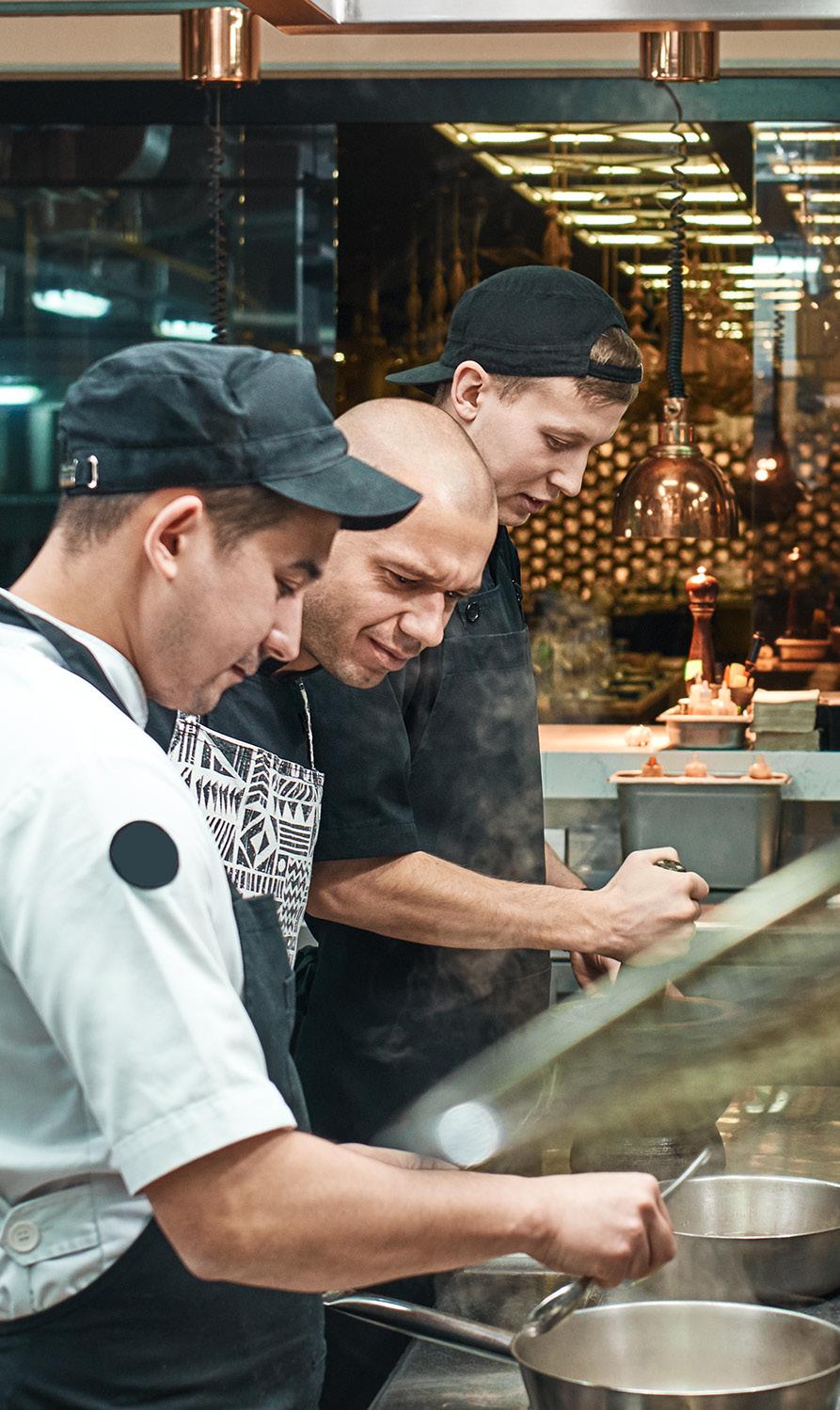
However, it’s not a plausible option for all; especially concepts that only open for dinner. Instead, think about what you can offer staff to ensure they stick around — a work environment that fosters people to grow in the business is the first step. Verbally acknowledging a staff member for their achievements and letting them know when they’ve had a good service can also go a long way. Gifting them with a meal at a venue of their choice or a bottle of wine from the cellar is an incentive for people to do their best.
A sit-down family meal is essential, and goes beyond sustenance, allowing staff to express their individual style of cooking and share it with team members. It’s also a good chance for staff to develop rapport with co-workers and the management team, too.
Getting out of the kitchen is also worthwhile. Think about taking a trip to visit a supplier or find a food expert who can share their knowledge on particular ingredients or techniques. Elijah Holland from LOTI in Melbourne takes his team foraging and diving for produce that is used in the restaurant, with the excursions becoming a big part of the appeal of working at LOTI.
Inclusive drinks
The zero- and low-alc movement shows no signs of slowing down, and it’s been a long time coming for a market that has been saturated with lacklustre mocktails. Thankfully, distillers and bartenders have caught up fast with the launch of products that imitate classic spirits, wines and beers that can be used and consumed in identical applications to their alcoholic counterparts.
Products such as zero-alc vodka, gin, whisky and orange liqueurs make it much easier for bartenders to add inclusive menu options that cover all the classics such as a Negroni, Italian spritz or a gin and tonic. There’s also the opportunity for bartenders to push their creative boundaries by creating drinks that hero non-alcoholic components without using liquor replacements. Bartenders can make house syrups and shrubs the focus of booze-free drinks and incorporate other products such as kombucha, sparkling water or tea to create holistic flavour profiles for guests.
Ovolo Group has honed in on its non-alc offering, with Beverage Director Andrea Gualdi (ex-Maybe Sammy) spearheading the initiative. “It’s really important for us to have non-alcoholic options because it is not just a temporary trend,” he says. “It’s really becoming its own category.”
Filling out the non-alc section of a drinks menu with soft drink, juice and water is no longer an option, and it’s essential to pay as much attention to the offering as the standard list. Much like dietary requirements, catering for all customers will make sure everyone has a positive experience at a venue.

32 | Hospitality FEATURE // 2023 trends

Brand collaborations
Chefs are inherently creative people, and external opportunities can provide a welcome challenge for creatives to do something a little different. Josh Niland recently teamed up with Talisker to headline a pop-up restaurant in North Head, Sydney, that was a first-of-its-kind collaboration. Niland says the difficulty of pairing whisky with fish was the initial appeal of the partnership, which saw the chef create three dishes with a whisky pairing.
Firedoor Chef Lennox Hastie has also recently worked with a liquor brand, creating a five-course menu inspired by The Balvenie’s Single Malt collection, which included two neverbefore-tasted samples from the Scottish distillery. “This is the first time I have chosen to collaborate with a brand in this way,” says Hastie. “Our shared values of dedication, commitment and obsession in achieving ultimate craftsmanship is what enticed me…” The project finally came to life last month after two years of planning.

Of course, partnerships are not limited to chefs, with bartenders also getting in on the action. Dean & Nancy’s on 22 in Sydney’s CBD set an Australian record with Woodford Reserve during Old Fashioned Week with the Gold Fashioned — the country’s most expensive cocktail. The $15,000 creation was made from XO Cognac finished Baccarat Edition, gold-infused Chateau d’Yquem reduction and handmade saffron and vanilla bitters. It was served with an engraved ice cube in a hand-cut French crystal Baccarat tumbler. Seriously luxe.
Multifaceted venues
Multi-concept venues have been taking the hospitality scene by storm in recent years, with larger operators providing three or more drinking and dining experiences at one location. Whether it is a casual bar, fine-dining restaurant or accommodation offering, guests can have it all and navigate their way through different spaces during one outing.

MGallery’s Porter House Hotel’s accommodation and hospitality offerings are split between two buildings on Castlereagh Street in Sydney. The hospitality venue features five levels of food and beverage experiences including Henry’s Bread and Wine delicatessen, restaurant Dixson & Sons and a newly opened cocktail bar called Spice Trader. The individual concepts have their own identities, but complement each other and the neighbouring hotel. “The intention was always for the hotel to be a sophisticated supporting act to the three dining and drinking destinations of Porter House,” says Erin Proud, director of guest experiences.
Having more than one concept in-house also allows operators to target both dine-in and takeaway customers. Loulou in Sydney’s Lavender Bay, founded by Etymon Projects, encompasses a bistro, boulangerie and a traiteur. Patrons can stop by the boulangerie to purchase pastries, the traiteur for charcuterie meats and ready-made meals and the restaurant for a long lunch or dinner.
34 | Hospitality
FEATURE // 2023 trends


Field trips
Provenance, locality and seasonality have long been key pillars in the culinary industry. Chefs and restaurateurs understand the value in knowing where produce comes from and sharing the knowledge with customers. Field trips provide an opportunity for a team to go straight to the source to learn about a particular region, climate or ingredient and mostly importantly, meet the producers. Staff trips can generate enthusiasm and inspiration while bridging the gap between the farm and the table.
The educational experiences have proven to strengthen team bonds and boost morale among staff. When internationally renowned Chef Curtis Stone opened Beverly Hills fine diner Maude, he took his team on trips across North and South America to discover different ingredients. The outings provided inspiration for the restaurant’s monthly menu, which highlights seasonal ingredients from California.
Team trips don’t always need to revolve around food, with visits to local distilleries, wineries and breweries providing a wealth of information to sommeliers, front-of-house and bar staff who can expand their food and drink knowledge.

Tech
Utilising technology is a must when it comes to streamlining operations in a hospitality environment. Rostering, navigating the ins and outs of bookkeeping and payroll can be a hassle for even the most efficient operators, but is made much easier by utilising apps and tech platforms that minimise stress.

In an industry with a large casual workforce and underpayment issues, it’s important to use tech to keep track of shifts to ensure staff are being paid in line with the relevant award. Allin-one platforms can also be used to train new recruits and get staff up to speed on everything from workplace health and safety protocols and venue news to responsible alcohol service practices and resources for mental health.
A smooth-running POS system is a crucial asset for any business, which is why integrated software is a must for processing customer transactions and payments as well as inventory management. The systems are continuously advancing, with many providing real-time data and reports that allow operators to remain agile in an ever-changing environment.
Streamlined systems are also useful in the kitchen, with most chefs preferring paperless platforms that can process both dine-in and takeaway orders. The platforms can also be integrated with delivery partners, ensuring any issues can be quickly rectified without impacting dine-in service.
Community-based initiatives
Building strong ties with the local community has always been important for hospitality venues, especially during the past two years. Now the industry is back in the swing of things, businesses are launching more community-based initiatives and activations to give back. From working with a reputable charity to showcasing local artists and musicians, more venues are looking to connect with the people who support them.
As part of its efforts to become carbon neutral, Sydney-based specialty coffee roasters Single O recently introduced a sustainability initiative called Gettin’ Loopy. The brand worked with local artists and businesses to create a series of consciously made products and merchandise including cups by Malcolm Greenwood Ceramics, upcycled tote bags from BagMeOut’s Gabi McInerheney and shirts with graphics by Artist Paul McNeil. While the project fosters collaboration, it also aims to promote social and environmental change, which represents the company’s overall ethos.

Hosting regular events and activations are a good way to target a broader customer base and can encompass everything from pop-ups and weekend sessions to live music. Baba’s Place in Sydney’s Marrickville hosts regular late-night sessions from 9:30pm until midnight, which sees a rotating line up of DJs and musicians play at the restaurant. Supporting creatives outside food and beverage can convey what a venue really stands for beyond its hospitality offering, with customers looking to have a good time while backing a good cause in the process.
Manual processes and outdated tech pose a risk to the viability of a venue, so it’s well worth investing in technology to ensure your business is in the best position it can be moving forward.
36 | Hospitality FEATURE // 2023 trends

TRY IT FOR YOURSELF! IMPOSSIBLEFOODS.COM Impossible™ Beef Mince Impossible™ Beef Patties Impossible™ Pork Mince Impossible™ Chicken Nuggets M a d e From Impossible™ChickenNuggets MadeFromImpossible™ Beef MadeFromImpossible™Pork MEAT MADE FROM PLANTS . Impossible Foods is now available in Australia. Scan to get a complementary sample today!
The class of 2022.
WORDS Annabelle Cloros and Aristine Dobson
HOSPITALITY MAGAZINE IS proud to present the second iteration of the 50 Gamechangers initiative. This year, the program celebrates the teams behind some of the country’s most groundbreaking venues that make up the diverse fabric the local industry is made of. From pocket-sized venues that serve 10 diners at a time to the establishments growing their own produce and others making a damn good bowl of noodles, the 50 Gamechangers quite simply do it like no other.
Ursula’s
Ursula’s is quite simply, a beautiful place to enjoy a meal in. Phil Wood and his wife Lis Davies poured their all into the neighbourhood fine diner in Sydney’s Paddington that goes heavy on the charm. Wood spent much of his career working under some of the world’s best chefs from Tetsuya Wakuda to Thomas Keller before helming Pt. Leo Estate. Years of experience in heavy-hitting kitchens culminated in Ursula’s; a restaurant that pays equal attention to the fit-out as it does to the menu. Diners are cocooned by periwinkle blue or pumpkin pie-coloured walls as much as they are by a plate of Moreton Bay bug pasta with parmesan and warming crustacean butter. The front-of-house team is lightning-quick on their feet, expertly delivering plates to linen-clad tables with a description of each dish, a smile and an “enjoy”.
Sang by Mabasa
Sushi Oe

Chef Toshihiko Oe helms the counter of his namesake omakase restaurant Oe, which is concealed behind noren curtains inside a Japanese restaurant on Sydney’s Lower North Shore. The space has six seats that surround the chef, who releases monthly bookings via text. It’s perhaps the most difficult seat in the city to nab, but it’s certainly worth the wait to experience the chef at work. Oe meticulously slices the seafood he purchases from the markets each morning, relaying the story and flavour profile of each piece as he places it in front of diners. Omakase means chef’s choice, and Oe’s is showcasing produce at the height of its season, whether it’s wild southern blue fin tuna or white sea urchin.

Moonah
Many restaurants preach a paddock-to-plate ethos, but Tobin Kent is one of a handful of restaurateurs who can call themselves the chef and the producer. Kent quietly opened his regional 12-seater in Connewarre, Victoria, two years ago and sustains the fine diner with 95 per cent of its fruit and vegetables from his own land and the surrounding area. Proteins are selected according to their sustainability credentials instead of their status and the wine list (also curated by Kent) spotlights makers with the same ethos as the restaurant. Kent and his team change dishes in line with ingredient availability, often having to think on their feet and innovate (a walk down to the wetlands is an example) when something runs out. It’s an approach that necessitates hard work and an adaptable mind, but it fuels what Moonah is all about; a produce-centric dining experience.

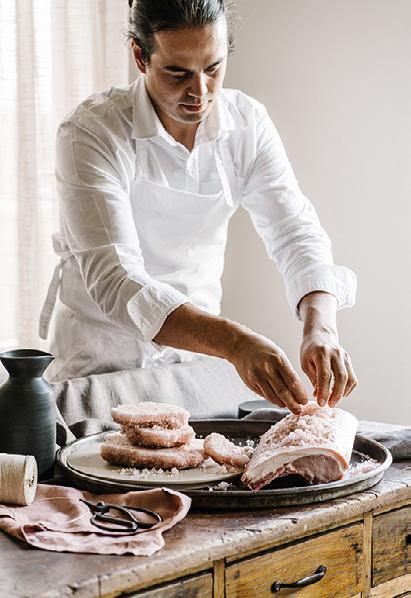 Photography by Marnie Hawson
Photography by Marnie Hawson
Sang by Mabasa in Sydney’s Surry Hills is run by Chefs Seung-kee Son, Jin-sun Son, their son Kenny Yong-soo Son and his partner Youmee Jeon. The hole-in-the-wall restaurant has never wavered on its journey of bringing traditional Korean dishes to the dining public since it opened back in Balmain. Dinner at Sang can look like yukhoe (raw Wagyu, Asian pear, cucumber, perilla, egg yolk, crispy mung bean); dak moraejip (charred chicken gizzards, garlic, green chilli, gochugaru, sesame oil) or bossam (pork belly, seasoned radish, ssamjang, salted shrimp, kelp, pickled gai lan). There’s a weekly lunch special for walkins, with everything from gimbap to yangnyeom gejang (marinated raw crab) running thus far. Sang is the type of restaurant that simultaneously evolves while staying true to its roots.
38 | Hospitality
FEATURE // 50 Gamechangers 2022
Kiln
There’s no doubt Mitch Orr was missed on the dining scene, and it was no surprise he was the chef of choice to front Ace Hotel Sydney’s signature restaurant Kiln. The rooftop eatery features panoramic views of its Surry Hills home and beyond, with the dining room structured around an open kitchen decked out with a woodfired hearth. Orr’s signature Jatz snack has returned alongside his high–low approach to cooking. Grilled Abrolhos Island scallops are paired with preserved lemon butter; marron with desert lime and long pepper and dry-aged rib-eye with ponzu. Mike Bennie is behind the wine list, and has curated mostly Australian/ boundary-pushing drops across glass, carafe, bottle and tap. Cocktails span Italian and Asian influences, with spritzes coming out as the drink of choice at the 108-seat diner.
Photography by Nikki To
Porkfat

Thai restaurants abound in Sydney, but Porkfat instantly changed the game when it swung open its doors in September this year. The dual-level Haymarket restaurant is the first venture from Long Chim alum Narin Kulasai, who worked in the kitchens of Bennelong and Nahm Bangkok before launching the restaurant. Porkfat’s menu features traditional recipes with a considered approach — all curry pastes and sauces are made in-house and used across dishes such as stir-fried sator beans with tiger prawns and a southern-style curry with prawns and black pepper. The staple papaya salad is levelled up with salted duck egg, while grilled pork jowl with smoked chilli jam nib is served with roasted rice, tamarind and lime. Dessert is not to be skipped on — and when there’s only one option, you know it’s going to be good. A scoop of Amphawa’s homemade coconut ice cream sees a snow-white scoop served with roasted peanuts, palm seeds and candied pumpkin — not too sweet and simply good eating.


Lana
Hinchcliff House’s upscale restaurant Lana was originally billed as a seafood/ Mediterranean-leaning concept, but it’s morphed into something much more under Chef Alex Wong. There’s no doubt the Sydney restaurant had a rough start, forced to open and close during lockdowns, but it hit its groove this year with a menu that blurs Italian and Asian influences into some of the best snacks and dishes currently going around in the city. Cucumber spears give a sushi experience with sesame and pumpkin seeds, while live lobster spaghetti is umami-ed up with XO, tomato, saffron and basil. The No Love Lost menu gave Sydneysiders an excuse to go out on Tuesday and Wednesday nights during the notoriously slow month of August, with the $79 multi-course menu providing a blank canvas for Wong to test-drive dishes and repurpose waste from the a la carte menu.
Photography by Hinchcliff House
10 William Street
It’s hard to believe 10 William Street has been open for 12 years, but then again, it’s difficult to imagine Paddington — let alone Sydney — without it. The restaurant’s pretzel with whipped bottarga is a must, with a cube of focaccia an essential add-on to finish the dip. The restaurant was one of the originals when it came to minimising the menu and focusing on quality, not quantity. There are always veg options (oft highlighting the best from Sift Produce), a handful of pastas, seafood (maybe snapper with spinach and buckwheat) and the stalwart tiramisu. Things are constantly changing over at 10 William Street under Head Chef Francesco Ruggiero, which means diners experience different plates each time they visit. The minimal-intervention wine list evolves as much as the food menu, with the blackboard the place to look for something new and exciting.

Serai

Modern Australian has long been a badge worn by restaurants with underlying European influences. But Serai is emblematic of what the term means in 2022. The Melbourne venue is Ross Magnaye’s first foray into the hospitality business, with the chef teaming up with his business partners to open the wood-fired kitchen in the CBD. Magnaye’s Filipino-Spanish background is scattered across the menu, but don’t expect dishes to take traditional forms. Sisig sees pig’s head encased in tacos, while kare-kare presents on a hashbrown with salted duck egg and optional uni. A natural wine-centric list is another attractor, with the cocktail list charting drinks that hero everything from house-made calamansicello to ube, single-origin coffee bitters from the Philippines and pandan. Regardless of what you order, it’s a guaranteed good time at Serai.
Photography
by Jana Langhorst
December 2022 | 39 FEATURE // 50 Gamechangers 2022
50 Gamechangers 2022
The Old Fitzroy Hotel
Historic Sydney pub The Old Fitz has seen many chefs pass through its doors over the past 100-odd years, but it has only recently become a launchpad for some of the city’s up-andcoming culinary talents. Odd Culture Group took over the pub in 2020, with Toby Stansfield (ex-Fabbrica) appointed head chef in June after Anna Ugarte-Carral announced her departure. Stansfield has taken on the challenge of running both the pub offering as well as Bistro Fitz, with the chef’s pared-back cooking style in full force across each menu. There’s campanelle with confit garlic, zucchini blossom and burnt chilli oil at the bistro, while rainbow trout is served with different components at the pub and the restaurant — think brown butter or watercress risotto. No pub menu is complete with a burger, and Stansfield’s prawn katsu with iceberg and cocktail sauce certainly does the job.
Club Fontana
It’s been a jam-packed year of restaurant openings for Sydney, but it’s a lot harder to launch a space that’s a head-turner from the jump. But if anyone could do it, it was the team behind the dearly missed Don Peppino’s consisting of Chefs Harry Levy and Daniel Johnston and Sommelier Ivey Wawn. Club Fontana in Redfern is an Italian-leaning restaurant and bar where patrons can dig into sardines on toast, carpaccio di tonno or a plate of spaghetti with prawns and pistachio — the gnocchi is pretty special, too. There’s also room at the bar for those keen to drop by for a glass of minimal-intervention wine and a snack at the good-times restaurant we didn’t know we were missing.
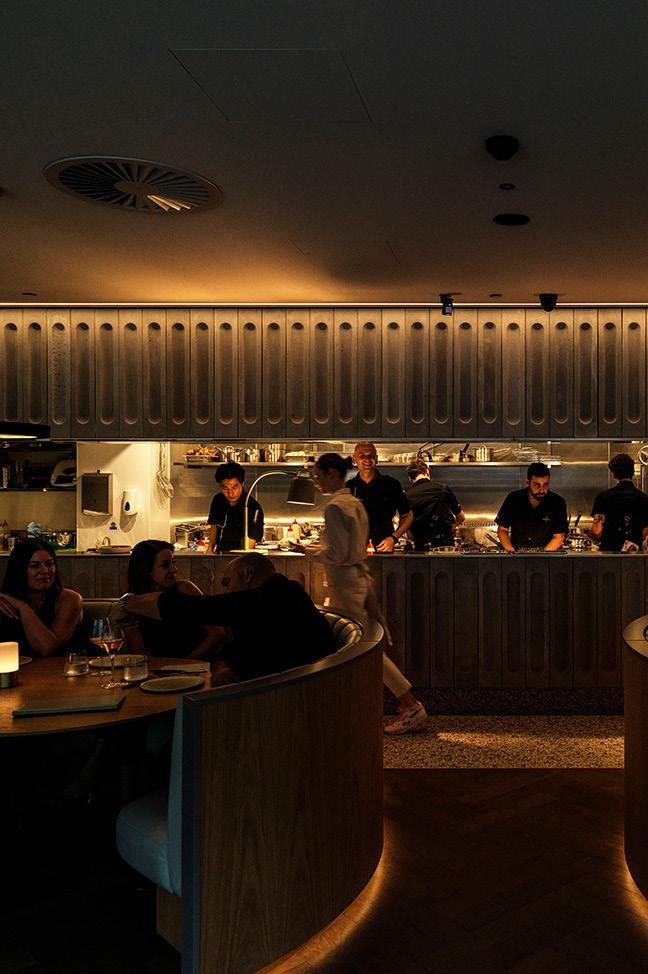
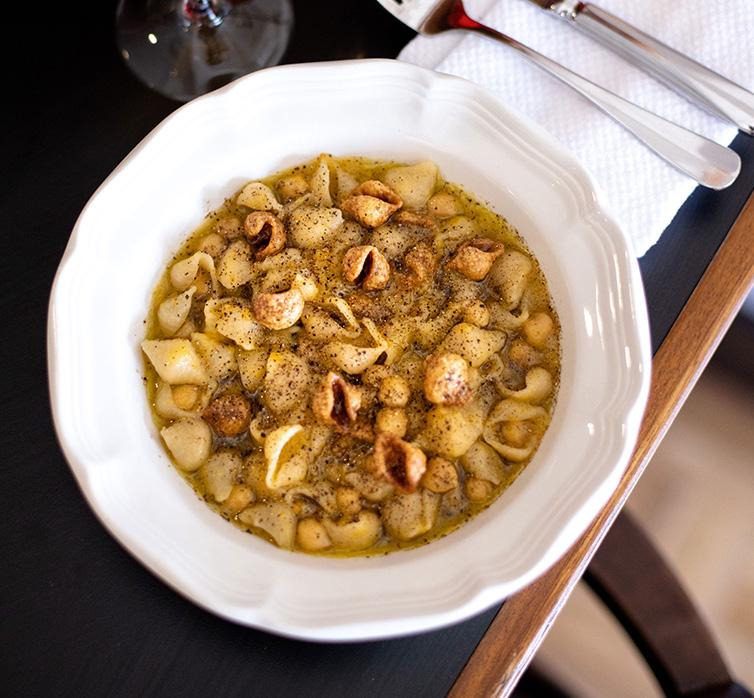


Lucky Kwong
Sydneysiders were beyond thrilled when Kylie Kwong confirmed a new opening in Eveleigh last year, a place described by the chef as a casual eatery for diners to refuel and recharge. It’s a venue that’s as much about the people who run it as the food on the plate, with both coming together to deliver a dining experience that’s both physically and emotionally nourishing. Kwong works closely with Cudgenburra/ Bundjalong man Clarence Slockee, who is the director of Jiwah and the force behind a 500m2 rooftop garden in the precinct. The garden is cared for by Indigenous community members who grow native plants, many of which are found on the menu at Lucky Kwong — peep the native bush mint found in the steamed spanner crab and prawn dumplings. There’s also seafood from Josh Niland’s Fish Butchery, vegetables from Palisa Anderson’s Boon Luck Farm and noodles from Jang’s. Lucky Kwong is all about establishing, amplifying and celebrating community connections, and it’s certainly doing just that.
Restaurant Ka
Chef Zac Ng worked in the kitchens of Sepia, XOPP and Flying Fish before opening his first restaurant in Sydney’s Darlinghurst this year. Restaurant Ka is tiny, but mighty, covering just 10 counter spots that encourages some serious face time between chef and guest. Ng is serving an eight-course dinner menu Tuesday to Saturday, with dishes charting Aylesbury Peking duck, trevally and tortellini stuffed with braised Bangalow pork belly so far. Patrons won’t know what they’re eating until they take a seat, which is part of the allure of the Ka dining experience: no expectations, just trust — you’re certainly in good hands.
 Photography by Jiwon Kim
Photography by Jiwon Kim
Aalia
The Esca Group launched Aalia earlier this year with former Fish Butchery talent Paul Farag heading up the kitchen as executive chef. Restaurateurs Ibby Moubadder and George Farah know how to deliver a quality dining experience (Nour, Lilymu), and Aalia is no different. The luxe Martin Place eatery hones in on Middle Eastern food culture, educating diners on the intricacies of cooking techniques, ingredients and flavour profiles found in Iran, Israel, North Africa, Egypt and Lebanon, to name a few. The menu is vast, but two dishes are not to be overlooked: waraq simsim (sea urchin with aged rice and cumin wrapped in a sesame leaf) and lamb neck shawarma served with tarator, pickles and Saida saj that’s expertly broken down by the front-of-house team. The wine program focuses on Middle Eastern wineries, with Head Sommelier Eleonore Wulf shining a much-overdue light on the historic winemaking region.
Photography by Jason Loucas
40 | Hospitality FEATURE //
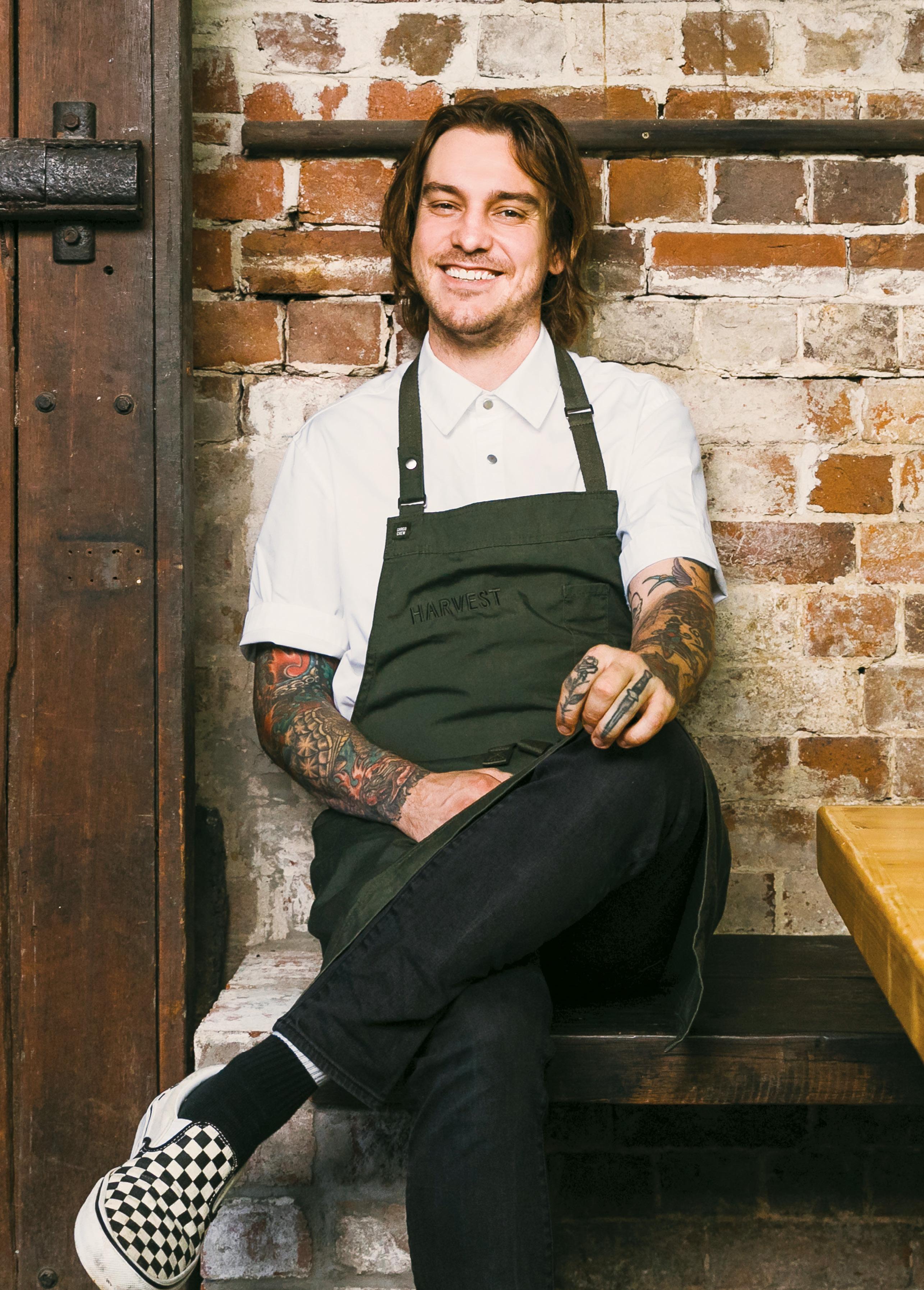
 Chef Matt Stone Ciao, Mate!
Chef Matt Stone Ciao, Mate!
Yugen
Hospitality certainly wondered where ‘sashimi florist’ Alex Yu would end up when he exited Chase Kojima’s Sokyo after a lengthy tenure, with the prodigy going on to front Yugen in Melbourne’s South Yarra as head chef. The high-glam subterranean restaurant is located inside the Capitol Grand building and is decked out with marble, stone columns, luxe chandeliers and moody accents, making it one of the most beautiful dining rooms to launch this year. The kitchen team is rounded out by Culinary Director Stephen Nairn and former Nobu chef Samuel Chee, who works alongside Yu in the sushi section. Speaking of sushi, Yugen recently announced the launch of its Yu-manned omakase, which booked out in minutes. There’s no quenching the demand for high-end Japanese food in Melbourne, but Yugen has raised the bar just two months in.
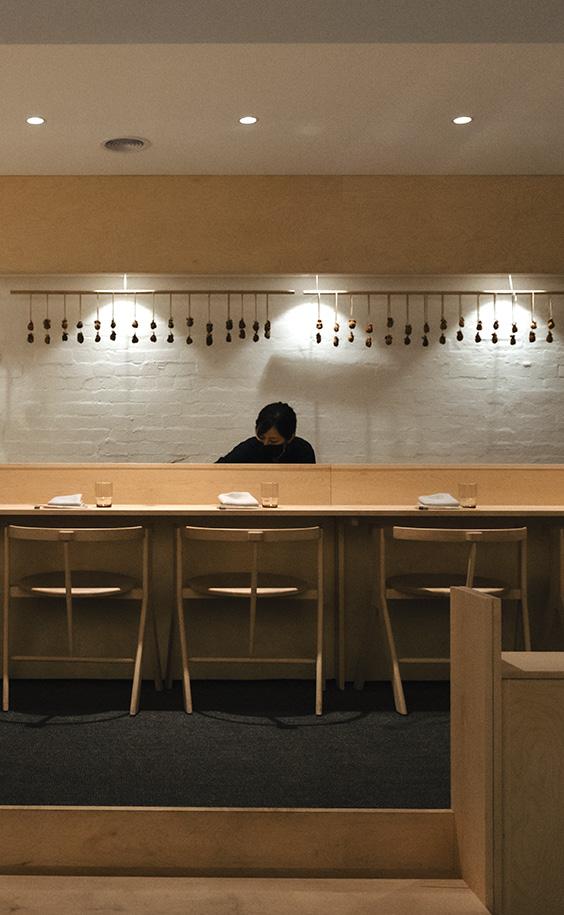
 Photography by Jason Loucas
Photography by Jason Loucas
Parcs
“Scrap is not a dirty word, ferments are the future”, tells you much of what you need to know about Parcs; a casual dining and minimal-intervention wine bar in Melbourne whose name is also a palindrome (of scrap). Dennis Yong heads up the kitchen after time working under Sunda’s Khanh Nguyen, and has put together a menu split into unripe, ripe and very ripe (dessert). Unripe naturally charts house ferments and preserves, Chinese donuts with mustard brassica dip and crocodile bacalao with orange kosho. Ripe covers kangaroo with treacle sauce and preserved beach herbs along with poached flathead with oyster shell beurre blanc and potato in kombucha. Parcs is a walk-in only restaurant (sans bookings for six-plus tables), which means it’s fair game when it comes to snagging a seat. Enjoy some plates with friends and a glass (or a bottle) from the wine list displayed on a chalkboard.
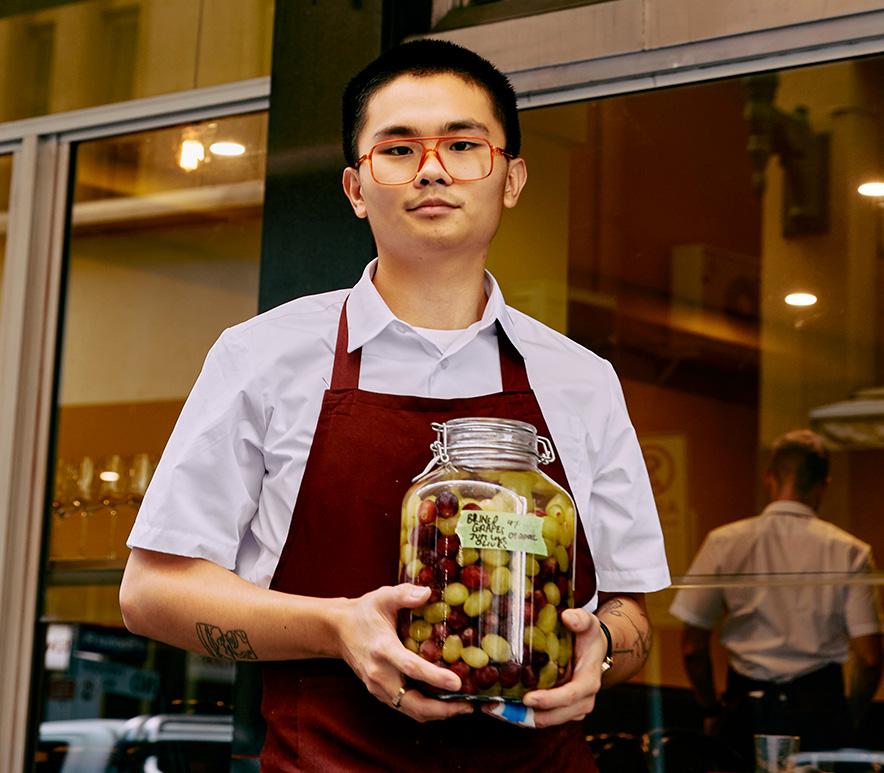
Leonie Upstairs
Hidden Melbourne gem Leonie Upstairs opened with one goal — to feed the neighbourhood it operates within — but word certainly spread fast about the Japanese sake bar and izakaya located behind a door in Hareruya Pantry. Kantaro Okada spearheads the operation, which is a team effort with wife and Chef Hitoe, who designed the menu to complement a vast sake collection that sees 15 options listed at any one time. Leonie Upstairs is the place to expand your sake knowledge and try a flight that might consist of stalwarts ginjo and daiginjo or kijoshu, which is the result of a sped-up fermentation process. Food is split into three categories: snacks, temaki and sweets, with the middle going on to become the signature of the venue. There’s 12 temaki options (including a nightly special) as well as a DIY set where guests can roll their own from a box full of fresh seafood, rice and nori.
Xi Bay
Consistency is key in restaurants, and northwestern Chinese eatery Xi Bay has certainly nailed the brief. The venue is located on Burwood Road in Sydney and specialises in handmade noodles spanning dry and soup applications as well as a long list of other dishes falling under the pillars of what’s new, cold options, daily meal (dumplings, rice, skewers), vegetables and meat. But you come here for the noodles — and there’s a minimum of 26 options to choose from. Oil-splash noodles are a must, followed by beef soup and roasted lamb, which hero noodles that bounce back when you bite into them. While there’s often a line, it moves fast, and your table will be filled with plates within minutes.
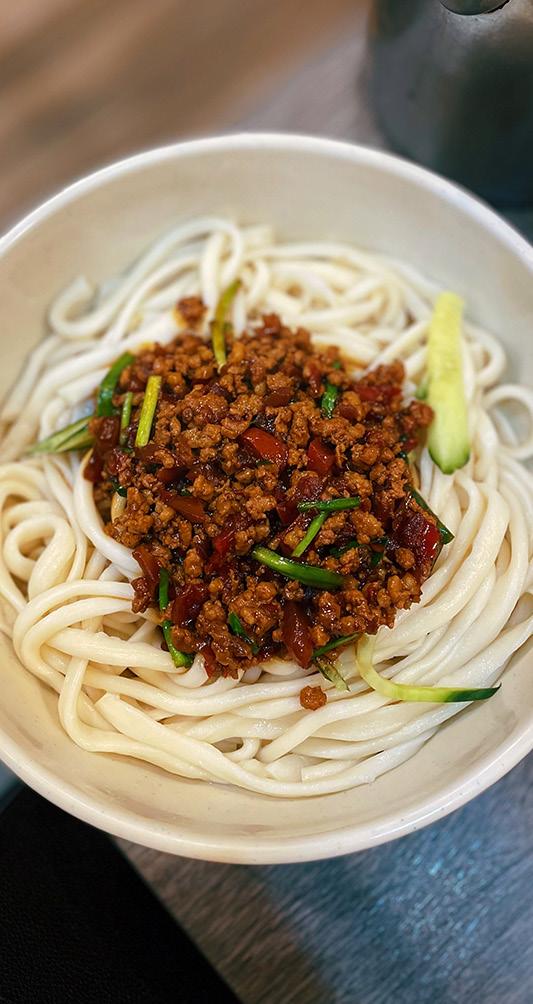
Navi
Chef Julian Hills grew up in regional Victoria, completing a Bachelor of Fine Arts (ceramics) before making his way into the kitchen. The chef has spent time learning about native ingredients from Indigenous foragers as well as ethical and sustainable framing practices from local farmers. The considered approach to cooking and eating sets Navi apart, with each dish put up during the degustation paying homage to the provenance of the ingredients, whether it’s kangaroo with nasturtium and egg yolk or spanner crab with radish and earl grey. The fine diner opened in mid-2018 and has recently expanded its presence with Navi Lounge, conveniently located next door. The lounge is a place for locals to drop by for a drink and enjoy a pared-back menu from the Navi kitchen team. But why not do both?
 Photography by Ed Sloane
Photography by Ed Sloane
42 | Hospitality FEATURE // 50 Gamechangers 2022
Soi 38
Noodle connoisseurs Soi 38 have “lifted a piece of Bangkok” and dropped it in Melbourne’s CBD — a carpark at 38 Mcilwraith Place, to be exact. It’s noodles for lunch and Thai street food for dinner at the venue, which is known for its tables to fill up fast. Boat noodles are the go for lunch, with bowls of oom kai (spicy chicken herbal soup), tom zap beef and tendon (spicy soup with slow-cooked beef and tendon) and tom zap kra du kaon (spicy soup with slowcooked pork ribs) rounding out the soup section of the menu. Come nightfall, it’s all about skewers, Thai BBQ and hotpot, larb and a deep-fried whole pork knuckle served with spicy sauce and sweet soy — a perfect match with Soi 38’s collection of natural wines from local producers Das Juice or Thai beer.
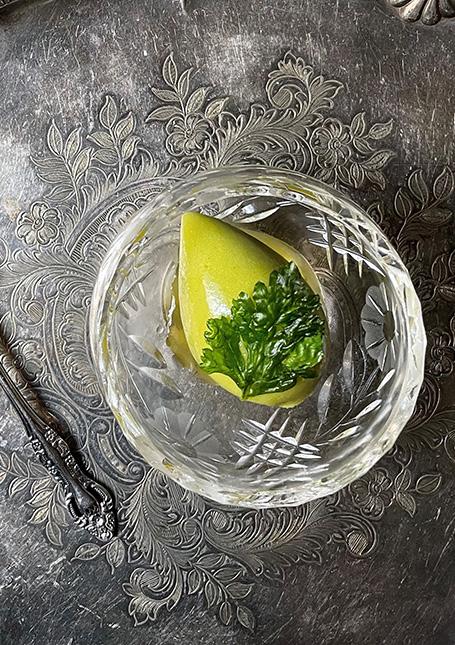
Aurora
Chef Brendan Wessels leads the team at Aurora, a restaurant located in the heart of Adelaide. Aurora’s ethos revolves around sustainability and local produce, with both elements illustrated by the plates that leave the pass. Wessels’ South African heritage is found across the menu, which is a collaborative effort with Head Chef Sam Cooper. But the plates at Aurora are farreaching when it comes to specific culinary influences. Cone Bay barramundi is paired with tabbouleh, fetta and shallots, while market beef comes with chimichurri and wattle seed mustard. Aurora is also part of Light ADL, a not-for-profit human enterprise. All profits from Aurora are funnelled back into the charity, which supports and provides opportunities to artists.
Photography by Jack Fenby
Rebel Rebel
Dier Makr
Chef Kobi Ruzicka worked in the kitchens of the now-closed Relae in Copenhagen and In de Wulf in Belgium before he opened Dier Makr in Hobart with Sarah Fitzsimmons. Thursday to Saturday, guests are presented with a menu that lists six or so dishes made with hyperseasonal ingredients. It’s a test of skill for Ruzicka, who practices fermentation and slow cooking to create options that go hand in hand with wine pairings from neighbouring bar Lucinda. Dishes are on until they’re not, with recent examples covering grilled white asparagus with black lip abalone and hazelnuts as well as confit gummy shark with grilled nameko, lion’s mane and buckwheat sauce.
You know you’re in for a treat when there’s a pig statue at the door, and that’s exactly what you will find when you walk into Canberra’s Rebel Rebel. The timber-beamed ceiling, black walls and open kitchen are other giveaways at the eatery run by Chef Sean McConnell and his wife Jenny Harders. Rebel Rebel serves lunch and dinner Wednesday to Sunday as well as breakfast on weekends, which offers a menu that goes beyond eggs on toast (but don’t worry, they’re on the menu “how you like ’em”). The offering is the same for lunch and dinner service, and sees Wagyu tongue served with peppers; beef tartare with anchovies, pickles and hot English mustard and grilled prawns with bay leaf butter. The wine list is unrivalled here, covering mostly local makers as well as pink, orange, white, red and fizz from France, Italy, Spain and beyond.
Agnes
Le Rebelle
A French neighbourhood bistro and bar in Mount Lawley, Perth? Sign us up. Le Rebelle covers a bistro, wine bar and dining room and offers a menu that’s a little bit French and a little bit New York. Coined as “the kind of place you would dine at in the old world”, Le Rebelle is also the kind of place you want to spend a lot of time in and is a credit to Owners Liam and Sarah Atkinson. Dishes include crab toast, glazed Wagin duck frites, a Wagyu burger stuffed with Beaufort cheese and pickled mussels served with potato rosti and saffron rouille. It’s perfect eating with a bottle from the snappy wine list, a classic cocktail or a glass of beer.
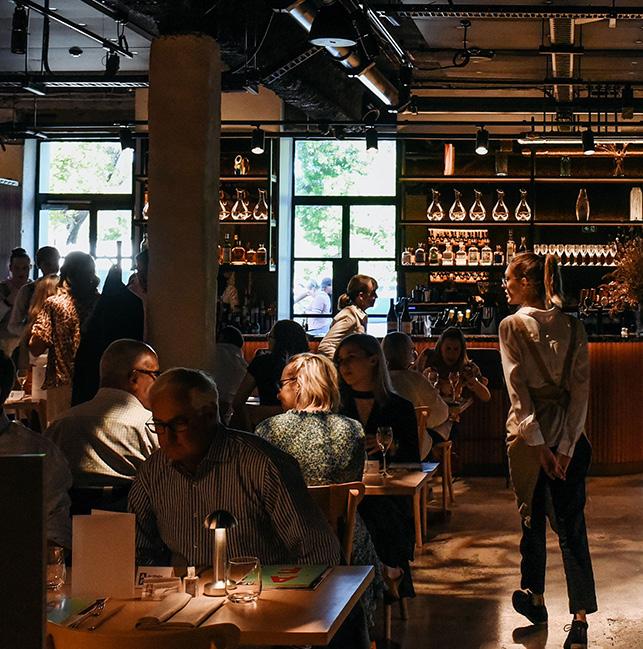


A restaurant’s ambiance is just as important as its menu, and Agnes in Brisbane’s Fortitude Valley ticks both boxes. The fine diner is the brainchild of Tyron Simon, Bianca Marchi and Executive Chef Ben Williamson, who have contributed something special to the city’s booming hospitality scene. Agnes is a celebration of ancient cooking practices, with the kitchen team using wood-fired hearths as opposed to stovetops. The converted warehouse space has a dry-ageing room, cellar and terrace bar that encase the main dining area, providing an immersive experience for locals and diners from afar.

December 2022 | 43 FEATURE // 50 Gamechangers 2022
Ante
Black Market Sake’s Matt Young and former Pinbone chef Jemma Whiteman launched Ante at the start of the year, and it fast become a local favourite in Sydney’s Inner West. The Newtown venue’s sleek interiors and extensive vinyl library are reminiscent of a Japanese bar, which goes hand in hand with its sake-centric offering. Ante’s range is made up of 65 sakes from 21 breweries across Japan. The food offering takes its cues from Japanese flavours and is designed to complement a guest’s sake of choice. Dishes include tagliatelle with fermented shiitake mushrooms and coral trout with tsukune and bottarga. There is arguably no better combination than sake, music and snacks, and Ante has hit the trifecta.

Ca Com Banh Mi Bar
Anchovy Melbourne’s spin-off banh mi offering boomed during lockdown, and the concept fast made it official. Chef Thi Le and partner Jia-Yen Lee started selling banh mi out of the window of Anchovy to keep themselves occupied while it was closed for dine-in service, before turning the space next door into Ca Com headquarters. Ca Com churns out a rotating selection of banh mi that sees ingredients packed into housebaked rolls. Le utilises various meat cuts and experiments with different cooking techniques to create her own iterations of the Vietnamese staple, which cover turmeric chicken, jungle-spiced pork sausage and Manchurian pumpkin.
Aru
Arkhé
There was much anticipation around the launch of Jake Kellie’s first solo venture Arkhé. After the chef headlined pop-ups around the country, he teamed up with Palmer Hospitality to bring Arhké to life. The 160-seat restaurant has since settled into Norwood, South Australia, and is delivering the country’s first open-flame dining experience. Its barbeque offering draws inspiration from Kellie’s time at Dave Pynt’s Michelin-starred restaurant Burnt Ends in Singapore. Guests can enjoy a cocktail at the bar before moving into the main dining area or chef’s table, where an open-plan kitchen allows diners to observe how the team cooks over an open hearth. It’s definitely a sight to be seen.
Sunda Executive Chef Khanh Nguyen opened the doors to his second restaurant Aru with Adipoetra Halim on Melbourne’s Little Collins Street in 2021. Aru is a self-described modern Australian restaurant, with the fine diner pulling inspiration from the wider Australasian region. The kitchen team takes a DIY approach to cooking, breaking down whole animals, cooking over open flames, curing, fermenting and preserving in-house. Native Australian ingredients are combined with traditional Asian elements, resulting in nuanced dishes that reflect various cultures. Nguyen is highlighting the history of seafarers who journeyed the SinoIndonesian-Australian route at Aru, leading to a culinary approach that centres around a vast plethora of flavours.
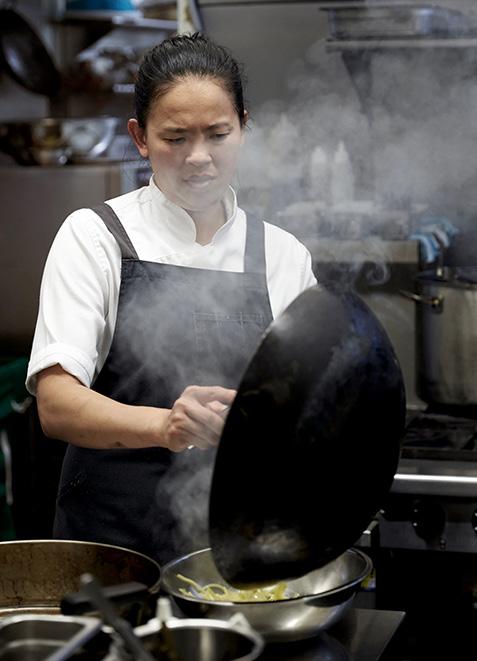
Bar Rochford
Located in Canberra’s historic Melbourne Building, Bar Rochford has become known as the city’s hub for good food and top-tier drinks. Owner and General Manager Nick Smith opened the doors in 2016, with the venue earning a hat just three years later. Its revolving seasonal menu, curated by chef team Josh Lundy and Belinda Barrett, covers a range of snacks, pastas, vegetable-driven dishes, desserts and cheeses. There are more than 120 wines listed on the beverage menu along with 20 by-the-glass options and an extensive selection of cocktails. Bar Rochford has stirred up plenty of interest across the country and is rightly considered one of Canberra’s go-to destinations. Photography by PewPew Studio
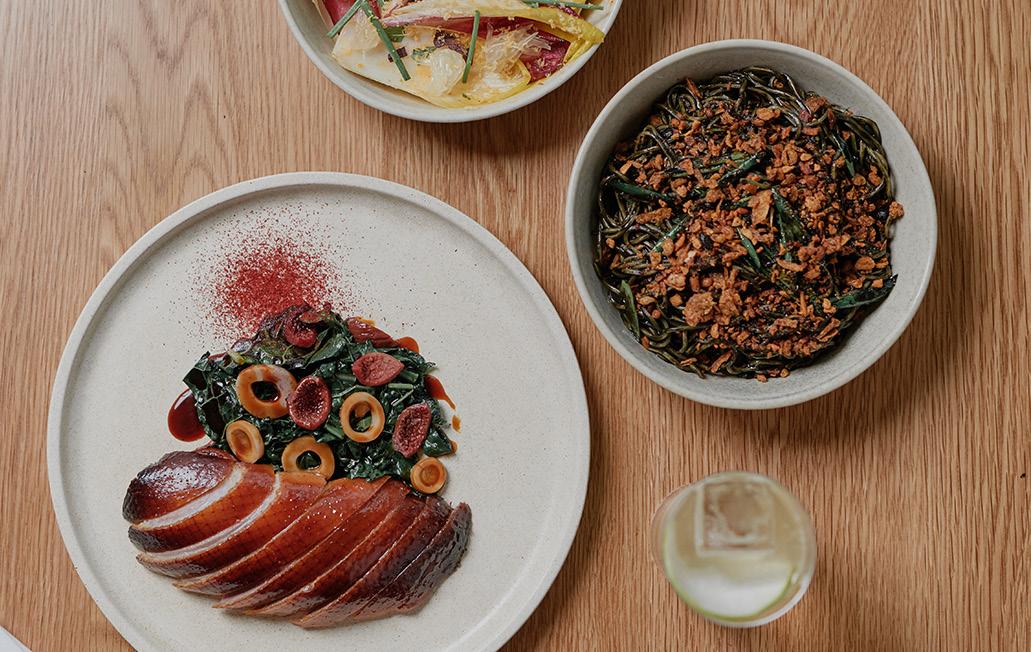


44 | Hospitality FEATURE // 50 Gamechangers 2022
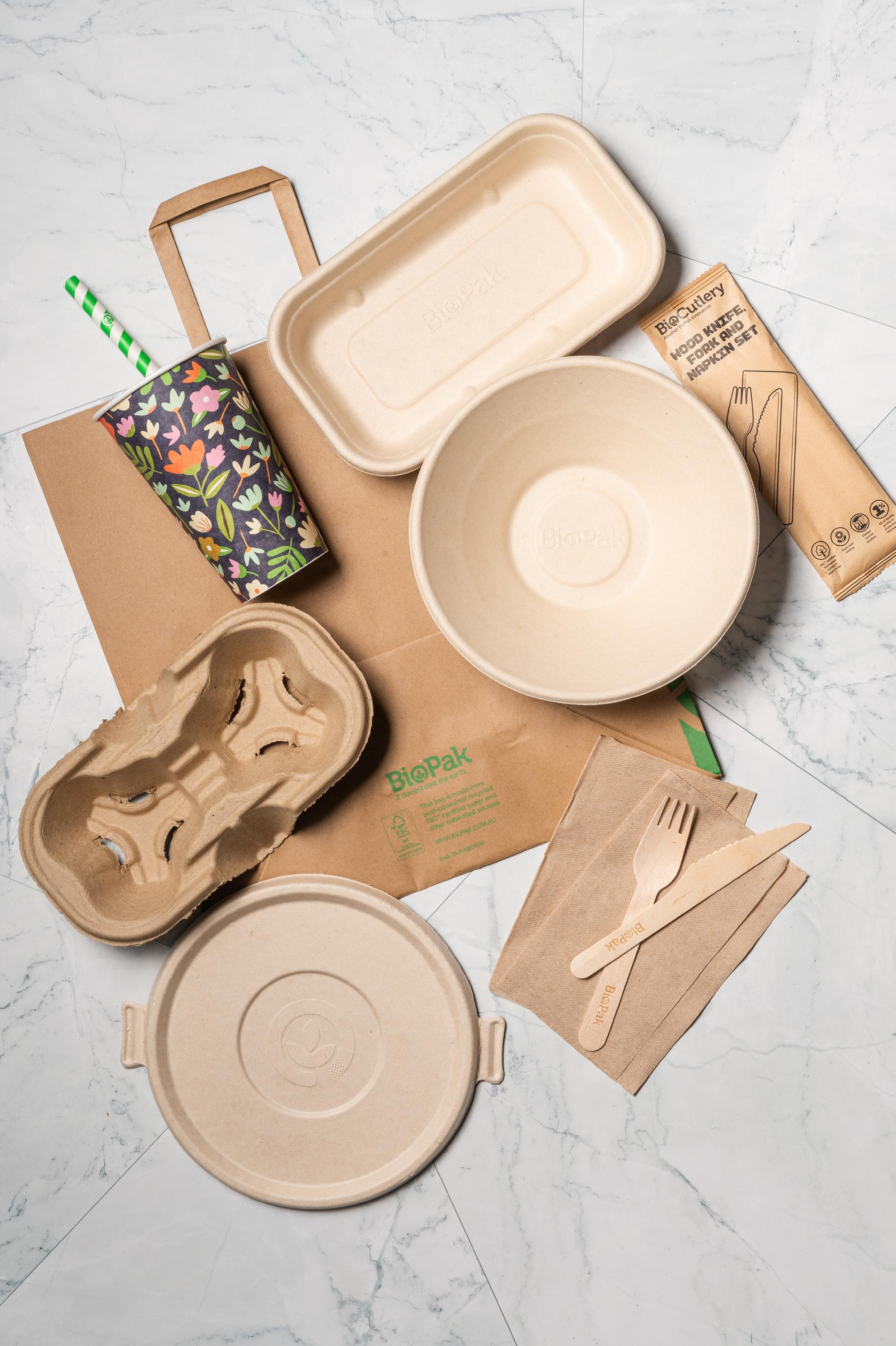

We’re a nonprofit that connects businesses to compost services, compostable packaging and educational material. Leave Nothing to Waste Find a Composter Compost Club Map Compostable Packaging Educational Support compostconnect.org
50 Gamechangers 2022
Doom Juice
Sydney natural winemakers Doom Juice came onto the scene during lockdown 2020 before going on to open the Inner West’s first cellar door. Owners Sebastian Keys and Zachary Godbolt are now making waves at the St Peters site with a courtyard restaurant and bar called St Lawrence Bistro. The weekly pop-up is held each Sunday with a different chef taking over the kitchen. The Old Fitzroy’s Toby Stansfield, Sagra’s Ed Saxton and Bastardo’s Jack Fitzhenry have graced the kitchen with menus that reflect their own unique culinary styles. There are plenty more events in the works, so keep an eye on the venue’s Instagram to see who’s cooking next.

Essa
Entrecôte
Melbourne’s Entrecôte pays homage to Parisian brasseries via its luxe décor and classic French fare. The restaurant spent seven years at its South Yarra site before moving to Prahran in 2021. Owner Jason McLaren Jones couldn’t be happier with the location change, and the local favourite continues to thrive in its new digs. The multi-level site encompasses a terrace, main dining room and courtyard, with each space designed to reflect the energy of Paris. French-inspired cocktails have been curated by Romeo Lane’s Joe Jones, which are an added bonus to Head Chef Tim Menger’s menu, which includes the not-to-be-missed steak frites. Entrecôte has certainly settled into its new home and continues to deliver high-quality French cuisine.
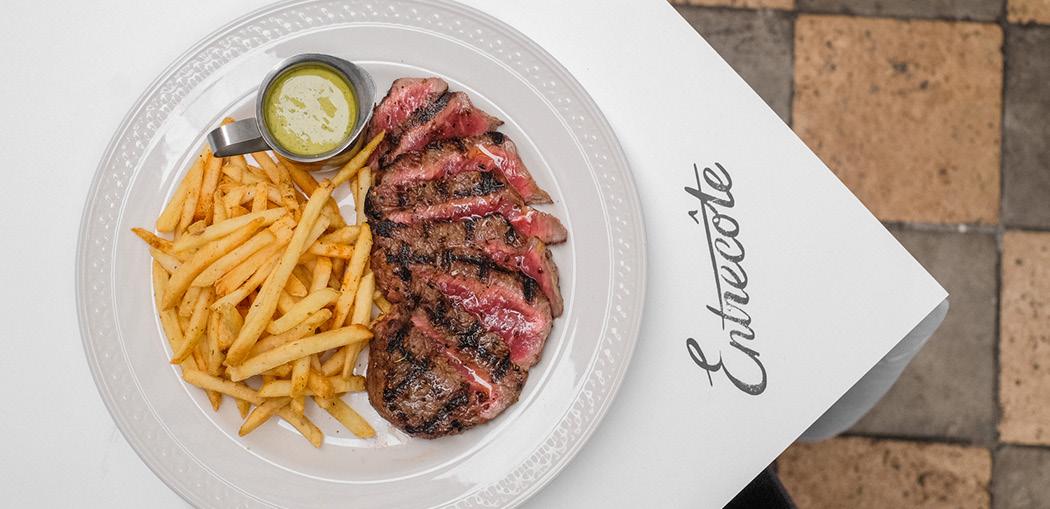
Gildas Wine Bar
Firedoor’s Lennox Hastie is taking diners to the Basque region with his most recent venture Gildas Wine Bar. Located down the road from Firedoor, the venue is an ode to one of the most iconic pintxos which sees an olive, a guindilla pepper and an anchovy speared together. Of course, there are many other dishes to get around on the menu, all of which showcase the finest produce of Australia and the Basque region. In the true spirit of local Spanish tavernas, Gildas encourages diners to delve into the wine and beverage selection as much as the food. A martini, please!
Photography by Nikki To
Chef Phil Marchant showcases the work of local farmers, providores and hunters at his 60-seat restaurant Essa in Brisbane’s Fortitude Valley. The kitchen is constantly changing its menu, with dishes dictated by the seasons and consciously sourced produce. The approach certainly broadens Marchant’s creative scope, with the co-owner focused on developing unique flavour combinations for guests. Examples include fried chickpea beignets with caramelised scallop cream and kaffir lime; burnt and baked saltcrusted kohlrabi with pepita pesto and raw kingfish with hazelnut miso, caper leaf and salted bergamot. The dishes scratch the surface of an inventive and ever-evolving menu that never ceases to surprise guests.
Fico
The pasta bar in Hobart opens reservations one month in advance — so consider this a reminder to snag a table. Fico has been around since 2016, with owners and chefs Federica Andrisani and Oskar Rossi combining Italian and Japanese influences at their restaurant since the start. The menu is sustained by local and seasonal produce, but there’s no sample menu to cast an eye over before you dine. Instead, guests are encouraged to sit back and relax in the same vein as the European custom, which implores an open-minded attitude. But if you must, Instagram is a good place to go to see past dishes, which include Bass Strait scallops with quark, horseradish and brown butter and tortello with a liquid tomato centre, basil and buffalo mozzarella cream. Fico is big on wine, securing several awards for its list that heroes Tasmanian winemakers and global styles.

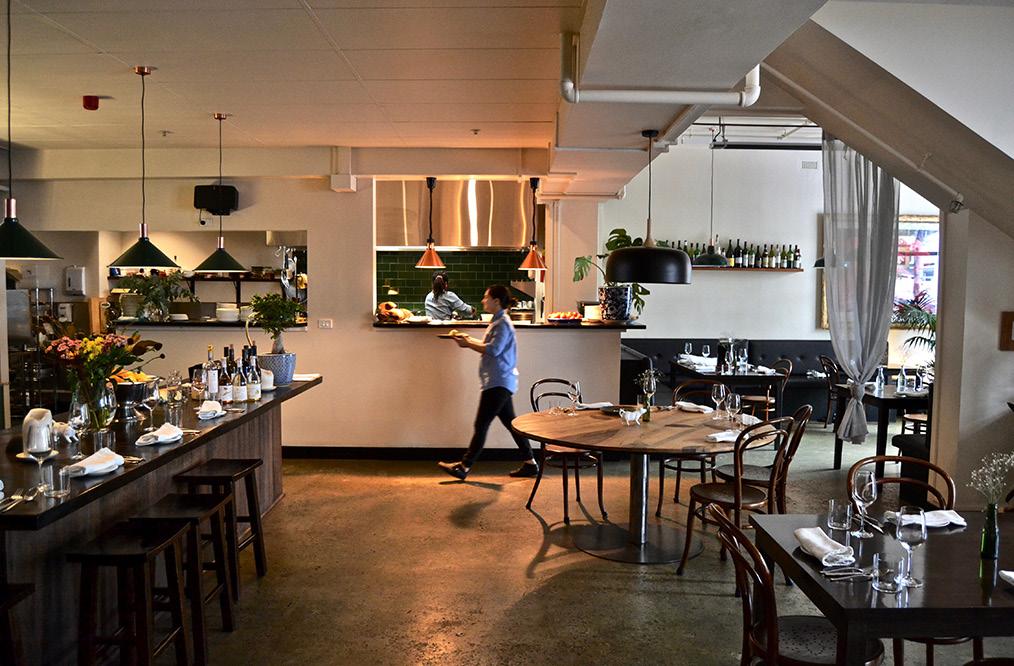
46 | Hospitality FEATURE //
Figlia
The Brunswick East location is the third venue from the team behind Melbourne’s Tipo 00 and Osteria Ilaria. Co-Owner Luke Skidmore and Chefs Alberto Fava and Andreas Papadakis chose to centre the industrial-style eatery around one of life’s great pleasures — pizza. But Figlia isn’t serving your typical margherita. Instead, toppings include duck mortadella, fermented cabbage and Moreton Bay bug. The food offering also encompasses antipasti dishes, stuzzichini (appetisers), mains, sides and desserts. While it may be a more pared-back and casual experience compared to the team’s other restaurants, the pizzeria delivers the same high-impact flavours and quality the trio are renowned for.

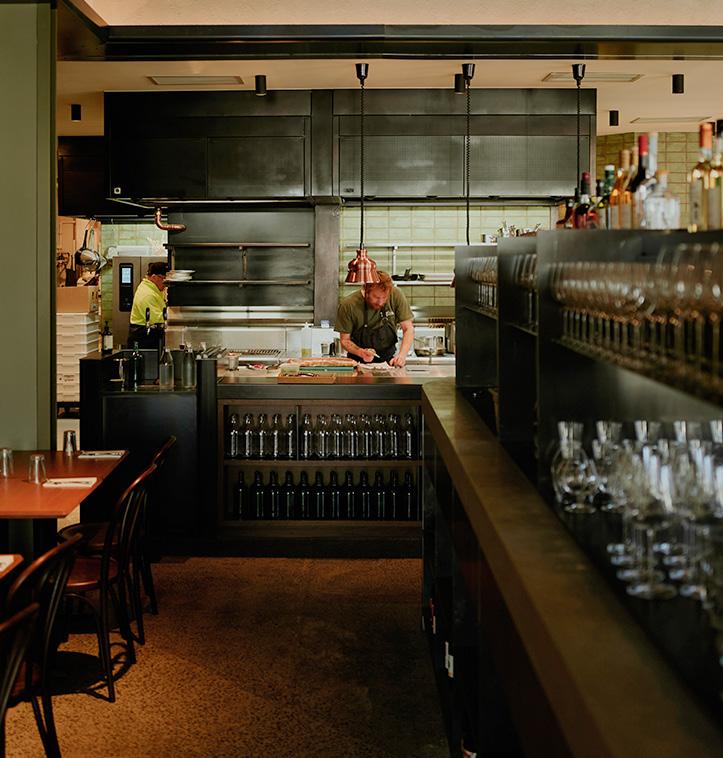
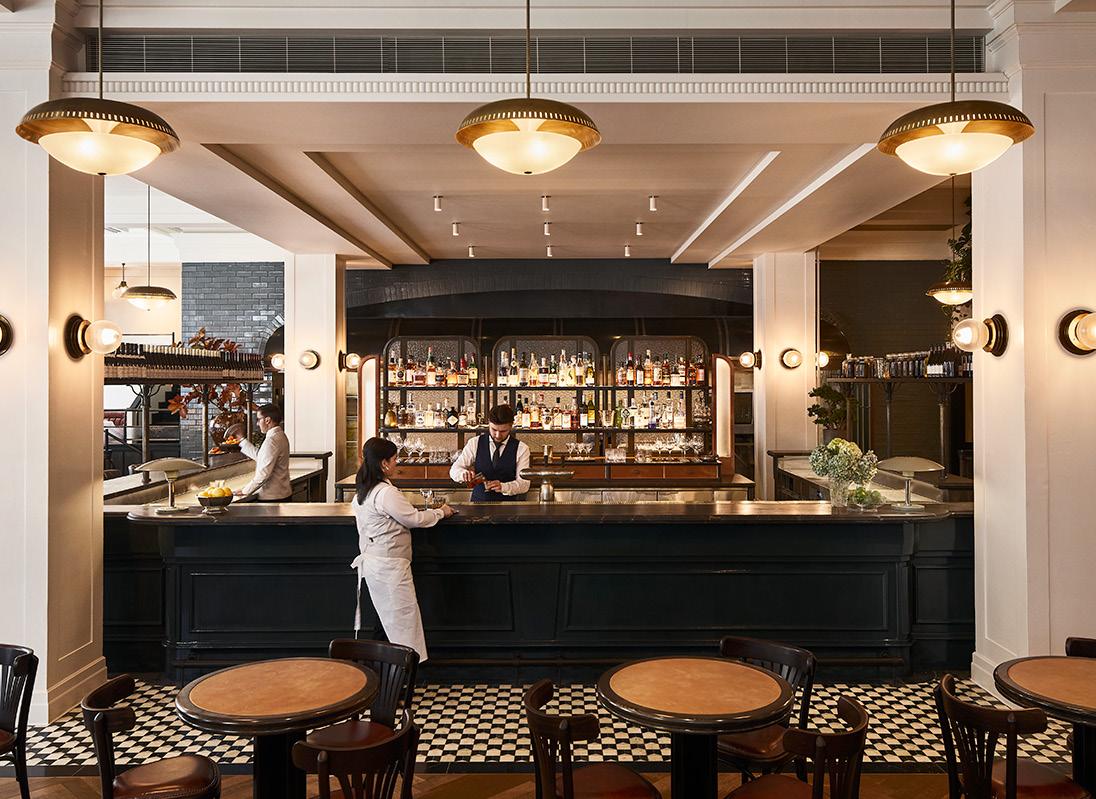
Photography by Kristoffer Paulsen
Gimlet
Freyja
Freyja moved into Melbourne’s heritagelisted Olderfleet building in June this year, occupying two levels of the landmark site. The restaurant takes a new Nordic approach to modern Australian dining, marking it as a concept that is taking its own path. Head Chef Jae Bang relocated from Norway after time at Michelin-starred restaurant Re-Naa in Stavanger to run the kitchen and has been an unstoppable force. Bang is working with fellow Re-Naa alum Aaron Caccia to present contemporary dishes made with traditional techniques such as pickling, curing, smoking, preserving and lacto-fermenting. A restaurant is only as good as its people, and Freyja certainly has a dream team.
Labart
Chef Alex Munoz Labart and his wife Karla Munoz Labart opened their namesake venue in Burleigh Heads with one goal: to serve dishes made from the best Australian produce. Alex worked as head chef at Sydney’s Monopole before making the move up north, where he is championing seasonality and simplicity with an everchanging streamlined menu. The chef is upping the ante when it comes to regional dining and is continuing to make his mark on the local dining scene with spin-off wine bar Paloma, which is all about elevated snacks and stellar wines.
Andrew McConnell’s Gimlet at Cavendish House in Melbourne showed the world the art of Australian hospitality this year, with the dining room snagging the no.84 position on the 2022 World’s 50 Best Restaurants list. Executive Chef Colin Mainds leads the kitchen, and has taken an immersive approach to the menu. A standout dish is the tableside tartare, which sees front-of-house staff compile the dish in front of diners. Cocktails are a key part of what makes Gimlet so special, with Bar Manager Cameron Parish constantly switching out drinks in line with seasonality. The stellar wine list from Beverage Director Leanne Altmann is the cherry on top, making the Gimlet brigade a force to be reckoned with. A spin-off Gimlet bar is also in the works — stay tuned.


Leigh Street Wine Room
Adelaide wine bar Leigh Street Wine Room is brought to you by one of the city’s leading hospitality groups Another Kind which is the work of Creative Director James Spreadbury and General Manager Meira Harel. What makes Leigh Street Wine Room so great goes beyond the 400-strong list of minimalintervention wines and extends to its award-winning interiors and expert team of staff. Not to skip on the menu, which charts everything from gnocchi fritti and tempura prawns to eggplant parmigiana. Leigh Street’s ethos is centred around good food and wine, and the venue has firmly established itself as one of Adelaide’s must-visit spots.
December 2022 | 47 FEATURE // 50 Gamechangers 2022
Restaurant Leo
Dynamo chef team Federico Zanellato and Karl Firla opened Restaurant Leo together in 2020, with spin-off café Picco Leo also joining the Angel Place dining precinct in Sydney’s CBD. The Italian-leaning menu spotlights humble comfort food found along the coast with its lobster maccheroncini and cuttlefish risotto fast achieving signature dish status. Handmade pasta is a core part of the Leo experience, with chefs making a realm of shapes from scratch every day. Practice makes perfect, and Leo has continued to evolve over its two-year life, plating everything from Sardinian fregola with mussels, vongole, hapuka and tomato to culurgiones with cime di rapa.
Vasse Felix
Western Australia’s premiere winery Vasse Felix has received much acclaim for its drops over the past 55 years, so it’s no surprise the estate’s hatted restaurant is held in equal regard. Head Chef Brendan Pratt jumped on board in 2017 after working in Michelinstarred establishments overseas and has made the restaurant his own over the past five years. Pratt has drawn inspiration from Vasse Felix’s award-winning wine portfolio to create the menu, which combines technical skills with produce sourced from the Margaret River. A visit to the winery isn’t complete without dropping into the restaurant, with the two experiences making for one memorable trip.
Hubert
Swillhouse’s Restaurant Hubert celebrates the finer things in life — think martinis, oysters, wine and smooth jazz. The underground Sydney CBD venue encompasses a large main dining area, bar, two private dining rooms and a main stage that hosts regular live music acts. It encapsulates the essence of Parisian bistros with the kitchen combining old and new cooking techniques and plating up dishes such as XO escargot, kimchi gratin, beef tartare and duck parfait. Not to forgo the long list of classic cocktails and wines which are in line with the timeless vibe. Hubert has been open for more than six years now, and the restaurant feels as relevant as ever.
The Hardware Club
Among the fleet of restaurants in Melbourne’s Hardware Lane sits The Hardware Club. Chef and Co-Owner Nicola Dusi and Andrea Ceriani opened the ’80s trattoria-style eatery in 2019, with the venue becoming a go-to for Northern Italian cuisine. The pair focus on handcrafted pizza, pasta and comfort food along with dishes from Dusi’s hometown of Valpolicella in Verona, Italy. Diners can expect the unexpected: think a deep-fried cacio e pepe toastie or roasted marrow bone toast with salsa verde. The playful menu rewrites tradition, which is part of the charm — not to forget the house-made limoncello.





Same Same
Same Same comes to you from the crack team behind Agnes, also located in Brisbane’s Fortitude Valley. Head Chef Jason Margaritis channels the diversity of Thai cookery on his menu, which sees classic dishes cooked over coals or in the wok. Betel leaf with eggplant, pomelo, fragrant chilli, cashew and mint is an essential snack, followed by the salt and pepper tofu burger with cabbage slaw and the boneless whole fried market fish with sweet four-chilli dressing, spring onions, ginger, Thai basil and coriander. The concept has been a fitting addition to the area’s dining precinct Ada Lane, which has become a hotspot thanks to its quality eateries and buzzy atmosphere.
48 | Hospitality FEATURE // 50 Gamechangers 2022
Walking together, working together. Although from very different backgrounds, these industry luminaries share many wonderful traits: talent, passion, respect and a great love for that no-waste, forever-giving, magical beast known as - The Pig. Masters of their crafts, they know full well, the endless delicious possibilities it provides. They are PorkStars.
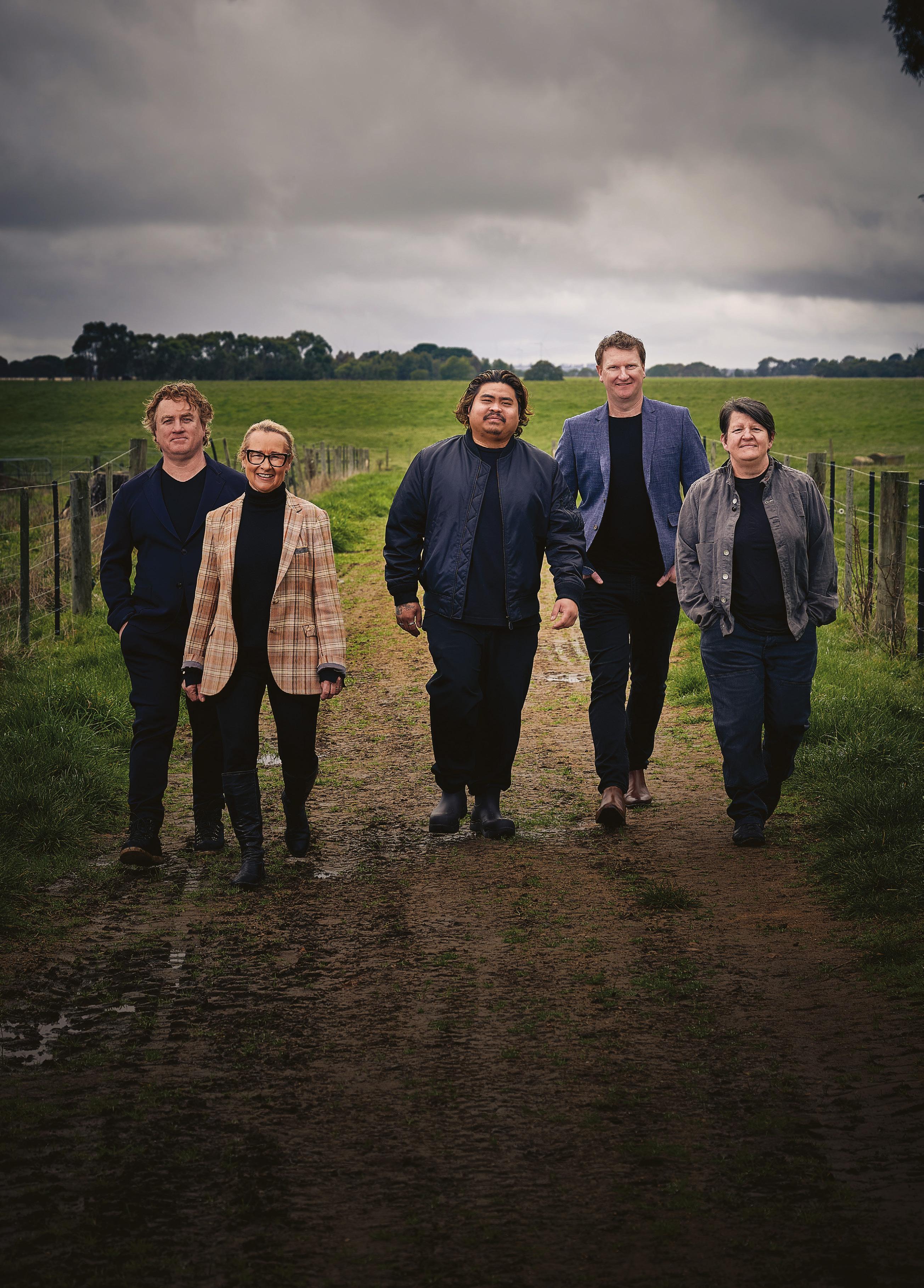 porkstar.com.au
Pictured (L-R): Adrian Richardson - Chef, Judy Croagh - Farmer, Ross Magnaye - Chef, Mick Nunn - Charcutier, Annie Smithers - Chef.
porkstar.com.au
Pictured (L-R): Adrian Richardson - Chef, Judy Croagh - Farmer, Ross Magnaye - Chef, Mick Nunn - Charcutier, Annie Smithers - Chef.
Van Bone
Van Bone celebrates Tasmania’s rich natural landscape through its small-scale culinary approach. Executive Chef Timothy Hardy, Restaurant Manager Laura Stucken and Garden Manager Joe Nalder had a vision to create an experience that would highlight local produce from the land and sea of Marion Bay — and the trio have done just that. Van Bone’s degustation menu covers 14 dishes which are based on the fruits of the restaurant’s market garden, which was designed by Hannah Moloney from Good Life Permaculture. Hardy works closely with Head Gardener Stuart Rose to plan the season’s harvest to sustain the 20-seat fine diner. It’s a labour of love for the team, who have taken the notion of provenance and locality to heart.



Kobo
Restaurant Botanic

There is a certain charm that comes with dining outdoors when a backdrop of flora and greenery is involved. Restaurant Botanic is found inside the scenic Adelaide Botanic Garden and provides guests with the opportunity to take in all the elements. Head Chef Justin James presents a tasting menu with more than 20 different flavour combinations that reflect the best of what South Australia has to offer from marron and green ants to finger lime and bunya bunya branches. The restaurant offers three different beverage pairings, which allow diners to choose their own adventure during the four-hour dining session.
Jacob Lee is the chef behind Sydney bapsang omakase concept Kobo, which stands for Korean bohemian. The pint-sized venue is the story of Lee’s life, with the chef referencing the Jeolla Province in Korea where his parents grew up and the time he spent with his grandmother, who taught him how to make sauces, pastes and ferments from scratch, as key influences. Kobo is an eight-seat restaurant without rules, with Lee designing menus — which he refers to as episodes — based on specific life events. Courses straddle traditional territory as well as others crafted with Japanese ingredients and local produce. The beverages are largely Korean, with camelia flower rice wine from Jeju Island served in a golden cup as a welcome drink, which is just the start of the many good things to follow.
The Summertown Aristologist
Pellegrino 2000
The trio behind French restaurant Bistro 916 in Sydney’s Potts Point delved into Italian cuisine earlier this year with the launch of their second venue Pellegrino 2000 in Surry Hills. Chefs Daniel Pepperell and Michael Clift helm the kitchen, with Sommelier Andy Tyson covering the drinks and front of house at the neighbourhood trattoria. The menu draws inspiration from Rome and Florence with standout dishes championing tripe and offal. There is plenty of pasta on the menu including a classic vongole along with pappardelle with lamb shoulder ragu. A busy venue is always a good sign, and Pellegrino 2000 often has a long line that snakes around the corner. It’s been a busy year for the team, who will open a New York-inspired seafood grill and steakhouse in the CBD come February 2023.
Winemakers Anton van Klopper (Lucy Margaux wines) and Jasper Button (Commune of Buttons) teamed up with former Orana manager Aaron Fenwick in 2016 to launch The Summertown Aristologist in Summertown in the Adelaide Hills region. What started as a canvas to showcase some of South Australia’s best wines has since evolved into a community-based venture. A rotating menu sees chef team Tom Campbell and Ethan Edie utilise sustainable seafood and ethically sourced meats from Adelaide farmers along with produce from the venue’s garden located in Basket Range. The kitchen takes a hands-on approach, and makes everything from charcuterie to butter in-house.
Photography by Duy Huynh
50 | Hospitality FEATURE // 50 Gamechangers 2022

Comes in various shapes and sizes
Prep bowls
Mise en place made easy.
Often sold in a set
Can be stacked neatly to maximise kitchen space
Easy to clean
Essential for mise en place
Larger
Durable stainlesssteel material

52 | Hospitality EQUIPMENT // Prep bowls
bowls can be used for mixing and whisking Separates ingredients for service

Contact: Simon York syork@intermedia.com.au Want to Communicate your product to over 100,000 hospitality industry professionals across print and digital? View our 2023 Media Kit here
Robin Wagner
The S.Pellegrino Young Chef Pacific region winner on the vegan dish that secured him the win.

MY WIFE WAS talking about the S.Pellegrino Young Chef competition and encouraged me to give it a go. I knew straight away I would present a vegan dish when I submitted the application. I was eager to represent myself and my style of cooking to the judges, other chefs and industry professionals.
I discovered a passion for vegan/vegetarian dishes (even though I am neither of them myself) over the past few years. My aim was, and still is, to showcase the potential a plantbased dish can have, especially when it has been prepared with thought and consideration.
The main idea for the dish [smoked celeriac with Granny Smith apple and crisp taro] never changed and was the same as it was at the beginning. At first, I had a vegetarian dish in mind, but it became vegan with small adjustments. I still have the very first pictures on my computer, so I can compare it to the presented version.
The problem with vegan dishes (most of the time) is the cliché that comes with them: tasteless, weird textures with no excitement made with the same products. I had to find a solution to make something rich, textural and interesting that was still refreshing.
Finding the right plate was a big challenge as the dish only works in a bowl that’s the right height and angle. It is a dish you have to dig into several times where you find something new each time. There are warm creamy textures at the beginning followed by crispiness and cold elements. The texture changes depending on how you start, but the flavour itself never changes.
[Josh Niland (one of the judges) saying it was the best dish he’d eaten all year] was an unexpected statement, which made me very, very happy. Josh is an amazing chef and a great inspiration, which made his feedback even more special. I always wanted to show that I can cook and am capable of creating a memorable dish. I think I gave the judges the chance to taste something memorable, but also the other chefs and industry professionals who tried it during the final.
Being the regional winner gives me the chance to represent the Pacific in the finals in Milan, Italy, and it really means a lot to me. As a chef in South Australia, I feel proud to represent the region on a national and international level. Once more information has been released, I will start to prepare myself and work with my mentor Peter Gilmore for the grand final round. ■
54 | Hospitality 5 MINUTES WITH ... //
Robin Wagner




*Must be a Qantas Business Rewards member. Maximum of 10,000 Qantas Points earned per policy. Available to new BizCover policy purchase only and not available with any other offer. See Terms & Conditions at bizcover.com.au/qbr The information provided is general only and should not be relied upon as advice. BizCover Pty Ltd (ABN 68 127 707 975; AFSL 501769) © 2022 BizCover. BC2235 bizcover.com.au 1300 805 821 Earn Qantas Points for every dollar spent on a new small business insurance policy* Compare multiple quotes online in minutes Instant online cover – no paperwork required Save yourself time and money Life is already ! Business insurance doesn’t have to be SCAN TO GET QUOTES


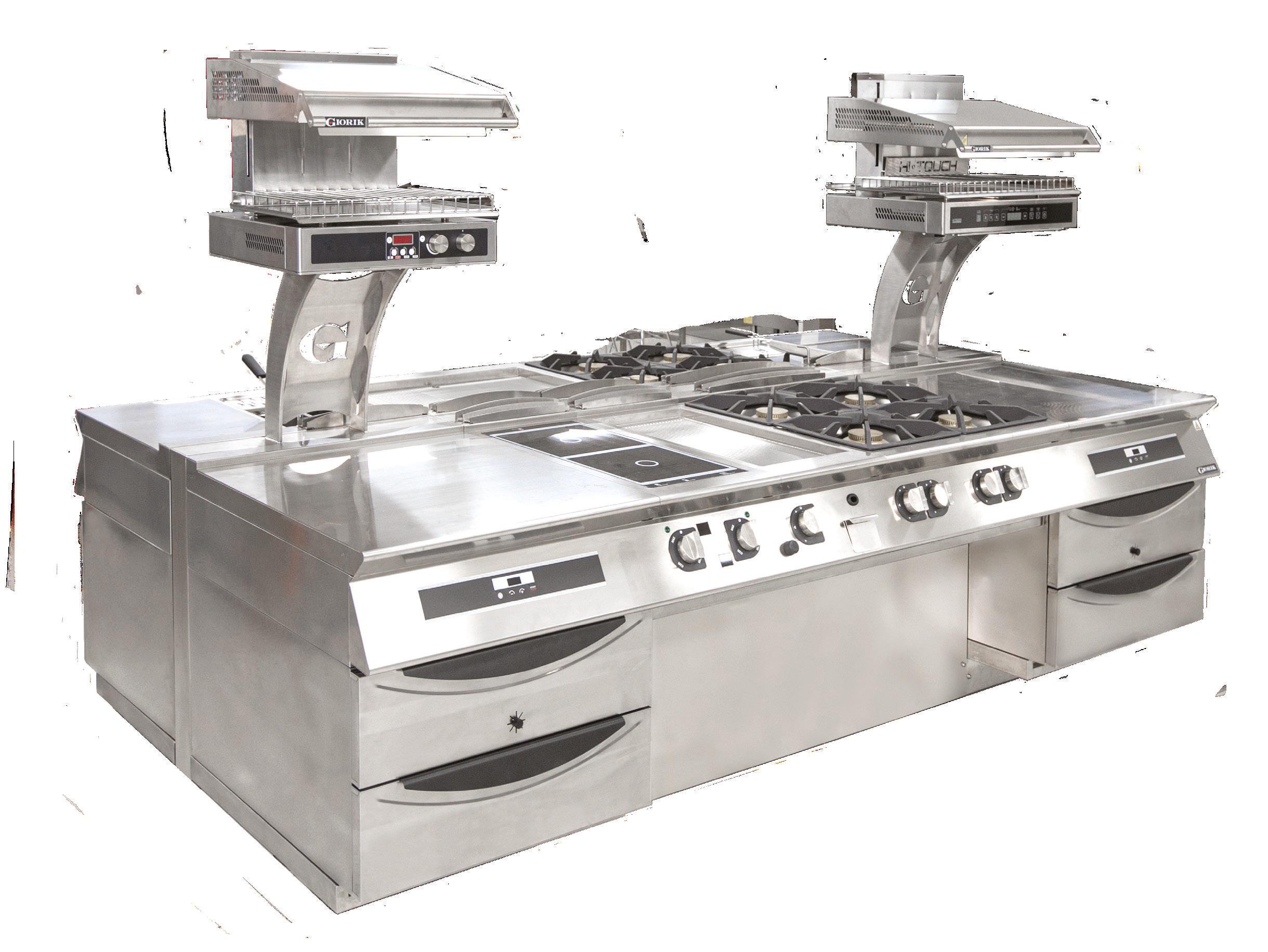



















 WORDS Annabelle Cloros
WORDS Annabelle Cloros

























 WORDS Annabelle Cloros
WORDS Annabelle Cloros

















 Head Chef Hector Chunga takes diners through the regions of Peru one dish at a time.
Head Chef Hector Chunga takes diners through the regions of Peru one dish at a time.


















































 Photography by Marnie Hawson
Photography by Marnie Hawson









 Photography by Jiwon Kim
Photography by Jiwon Kim

 Chef Matt Stone Ciao, Mate!
Chef Matt Stone Ciao, Mate!

 Photography by Jason Loucas
Photography by Jason Loucas


 Photography by Ed Sloane
Photography by Ed Sloane


























 porkstar.com.au
Pictured (L-R): Adrian Richardson - Chef, Judy Croagh - Farmer, Ross Magnaye - Chef, Mick Nunn - Charcutier, Annie Smithers - Chef.
porkstar.com.au
Pictured (L-R): Adrian Richardson - Chef, Judy Croagh - Farmer, Ross Magnaye - Chef, Mick Nunn - Charcutier, Annie Smithers - Chef.


















